To visit my favourite garden in the entire world is always a special gift, so when I heard that my gang of garden bloggers had chosen Philadelphia to be the centre of our annual Garden Bloggers’ Fling in the last week of September, I was ecstatic. Even if Chanticleer had been the only garden we saw, it would have been enough, in my view. But of course it wasn’t; we saw many beautiful gardens. But let’s start here with a map, to familiarize you with the various theme gardens on the 35-acre property.
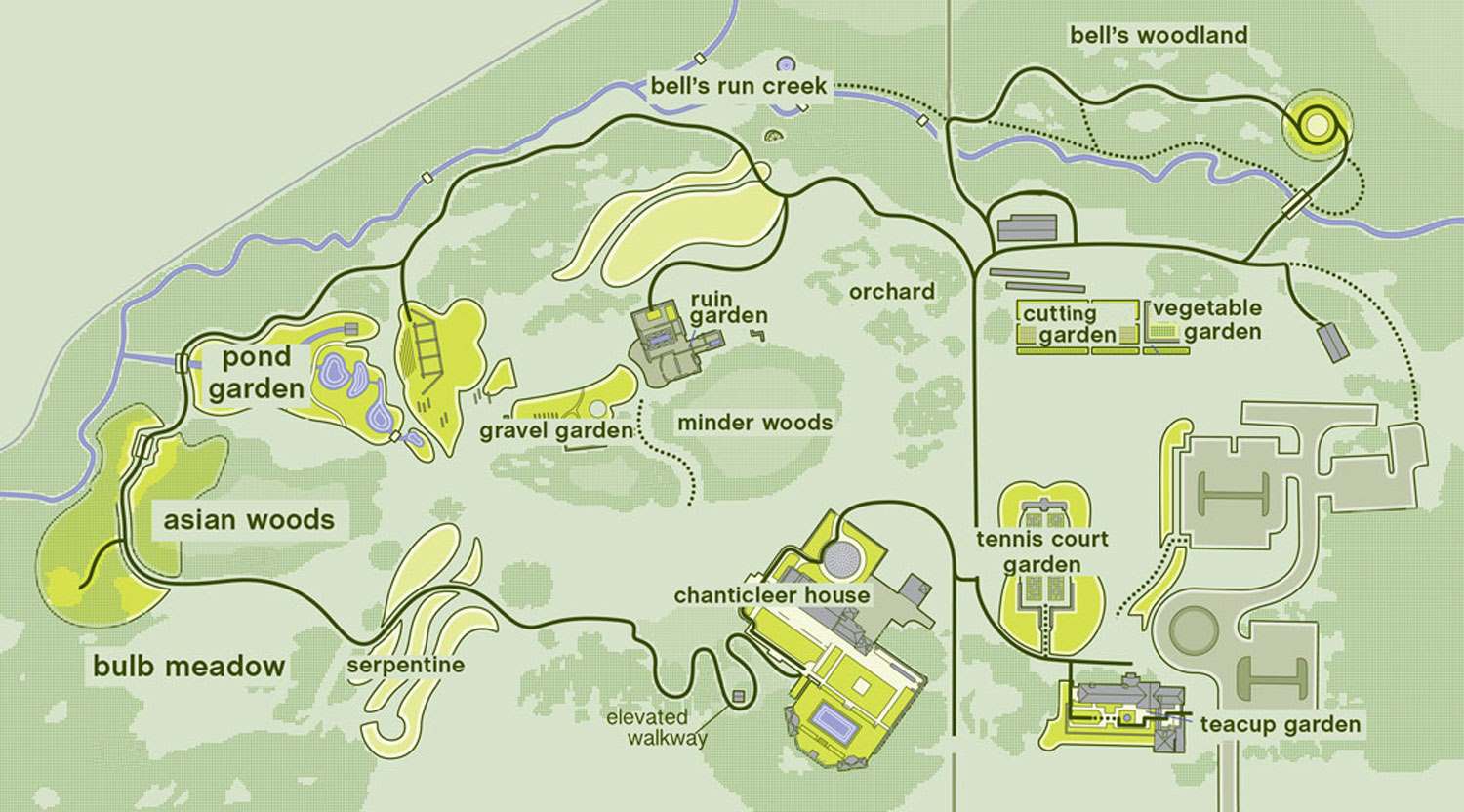
The thing about Chanticleer is that you can visit at different times of the year and see a very different garden; there is never enough time. After visiting in June 2014, I wrote a 2-part blog filled with poppies, foxgloves, sages and alliums. In May 2022, I used my blog to trace the history of the Rosengarten family, who in 1913 made their summer home here on Philadelphia’s Main Line in the town of Wayne; a decade later it became their full-time residence. There were peonies, columbine, wisteria and tuliptree in flower on that enchanting spring visit. But no matter which season, I always begin in the Teacup Garden, named for its distinctive overflowing fountain. This is like a tiny, perfect stage set filled each year with a new cast of characters, always with its own colour scheme. Sometimes it’s a dry garden, often tropicals mix with annuals. This year, if asked to name it, and considering the silvery Senecio vira-vira and olive trees, I might offer “pewter perfection”.
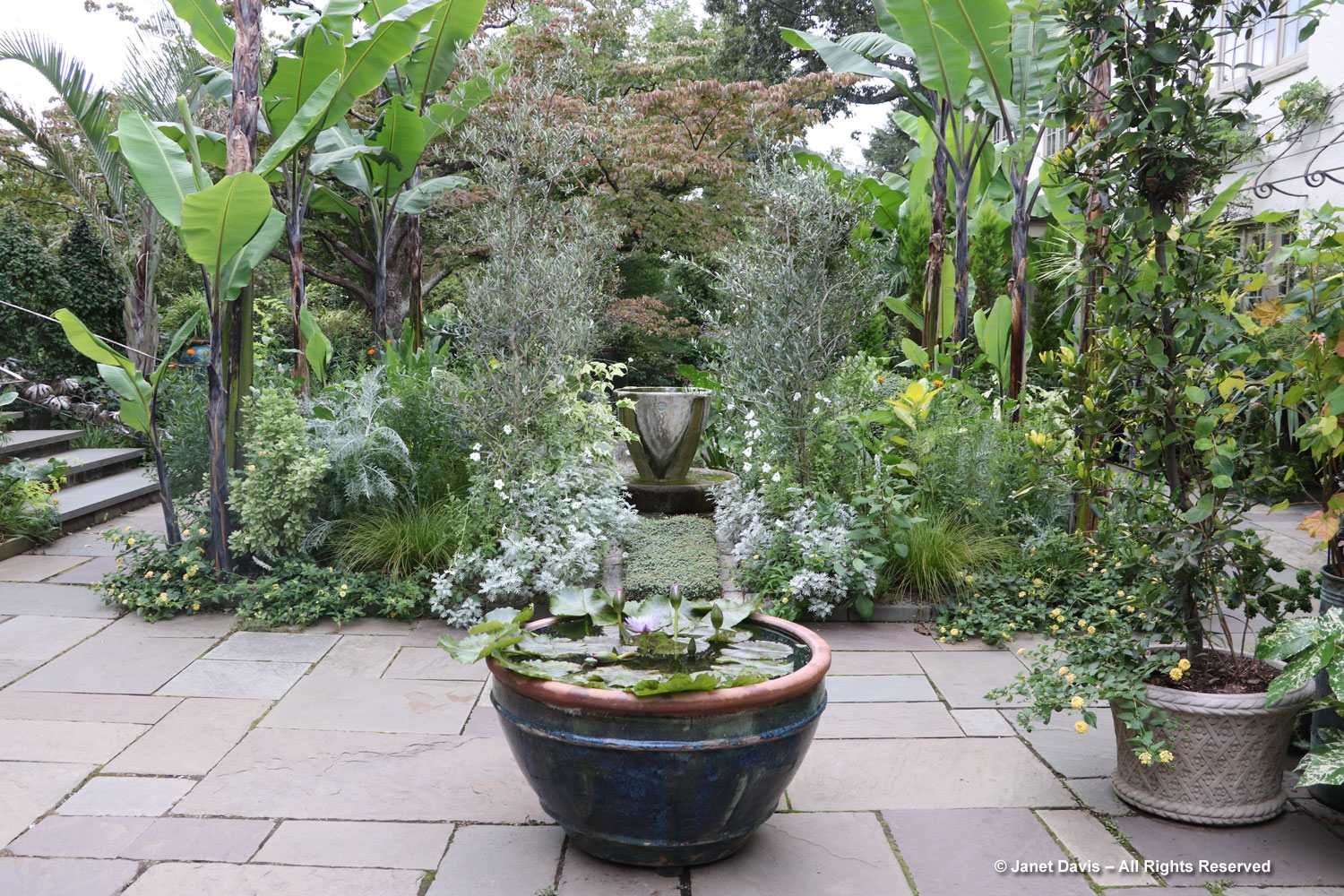
The basin in front of the garden is resplendent with a day-blooming tropical waterlily.
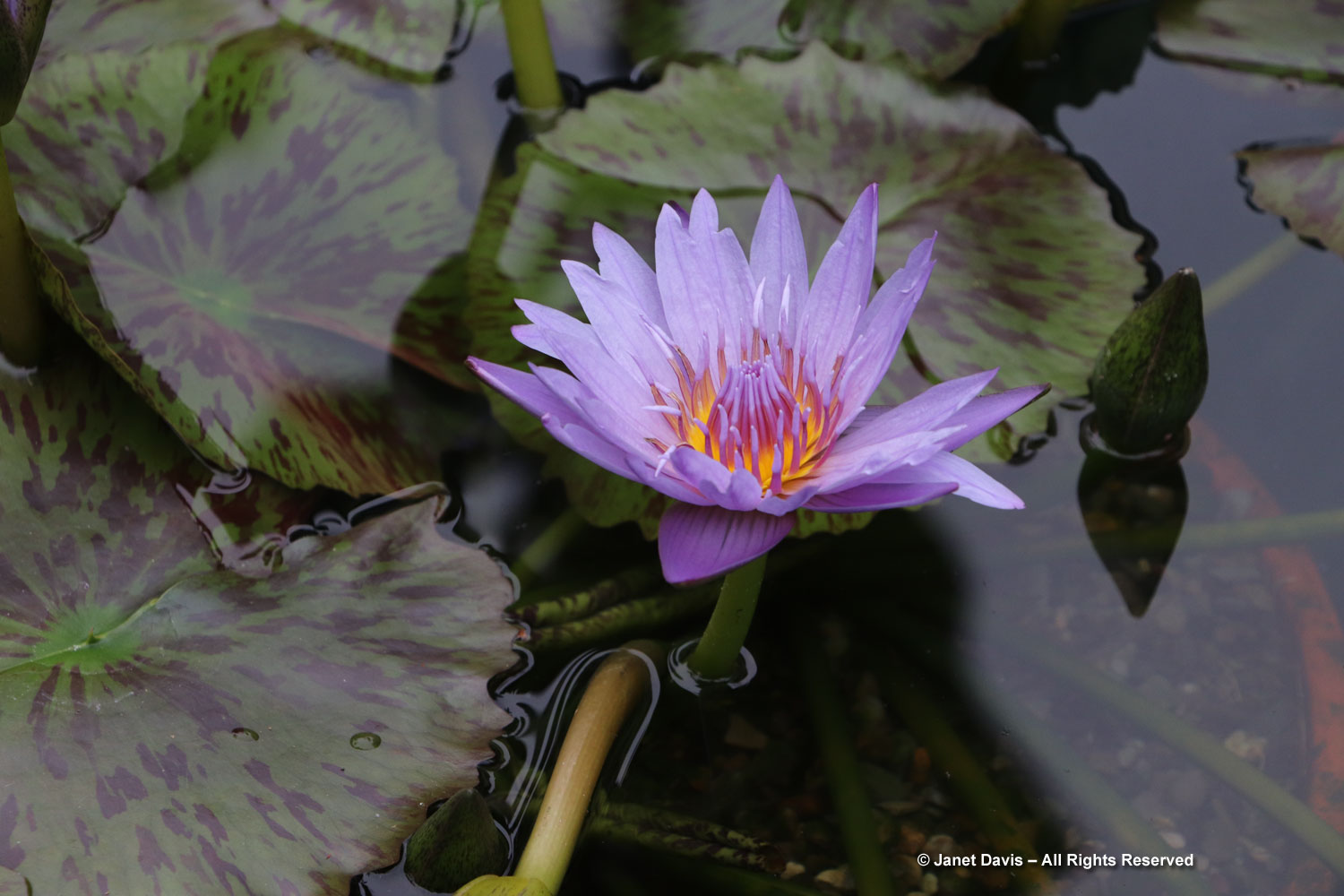
The fountain originated with the Rosengarten family….
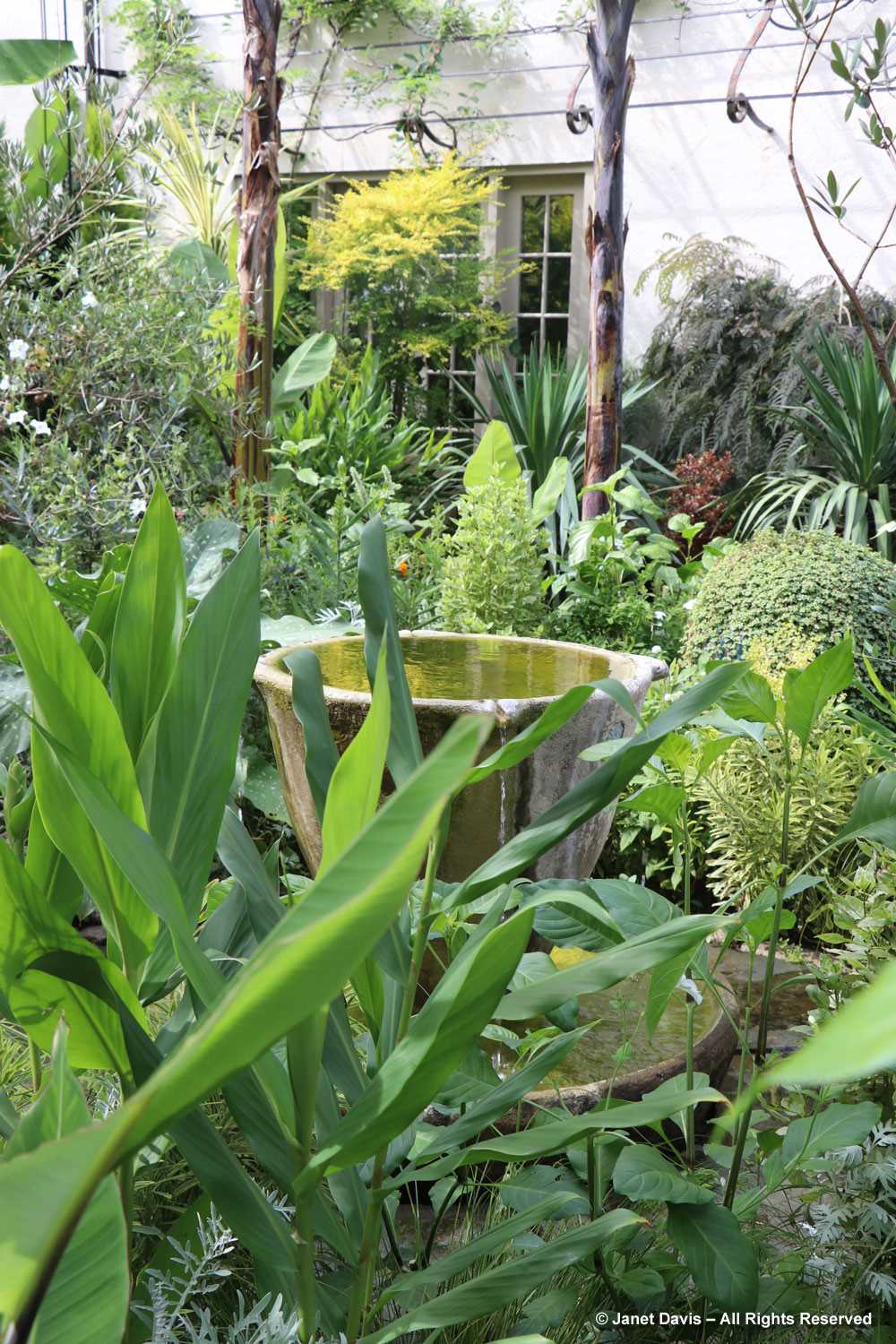
…..and is believed to have been purchased by them in Florence, Italy in the 1920s. The pretty building adjacent to the Teacup Garden houses Chanticleer’s administrative offices. It was originally the home of Alfred Rosengarten’s daughter Emily, built for her on her wedding in 1935. The Rosengarten family home itself is called Chanticleer House and has its own gardens.
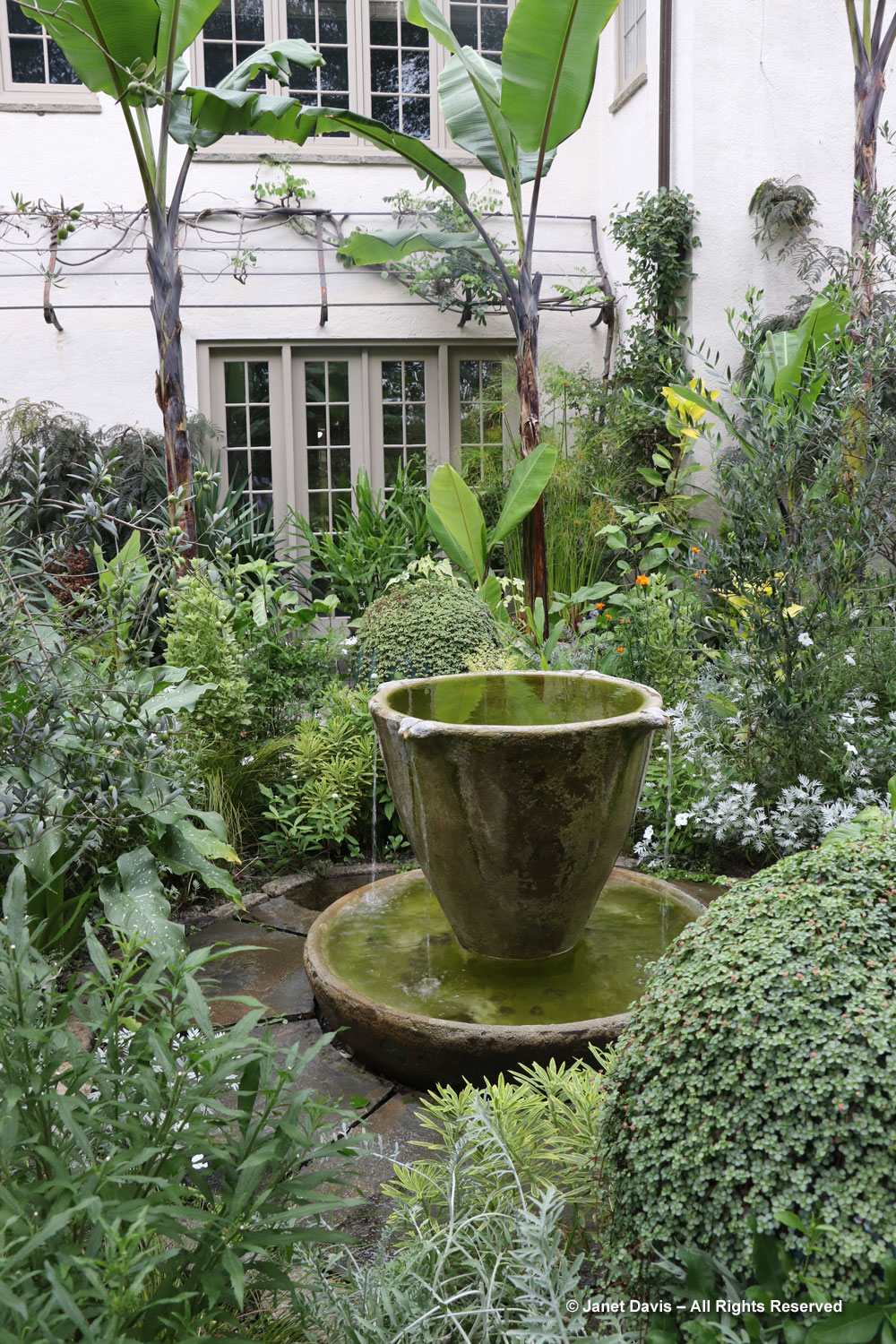
The Teacup Garden features a number of urns and pots, like this glazed, teal-blue urn filled with a stunning, chartreuse jasmine called Fiona Sunrise (Jasminum officinale)….
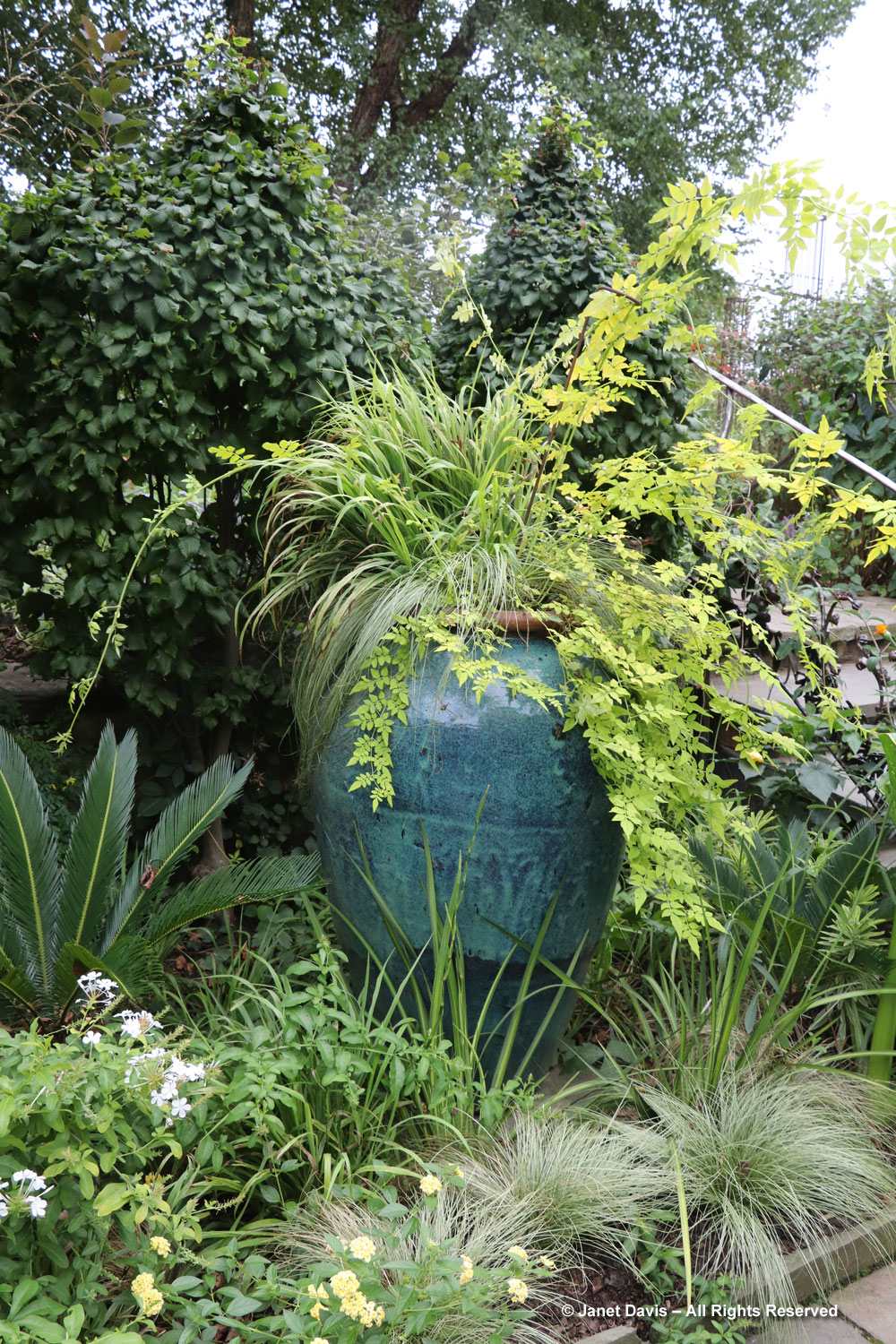
… and this one, draped with Pilea glauca ‘Aquamarine’.
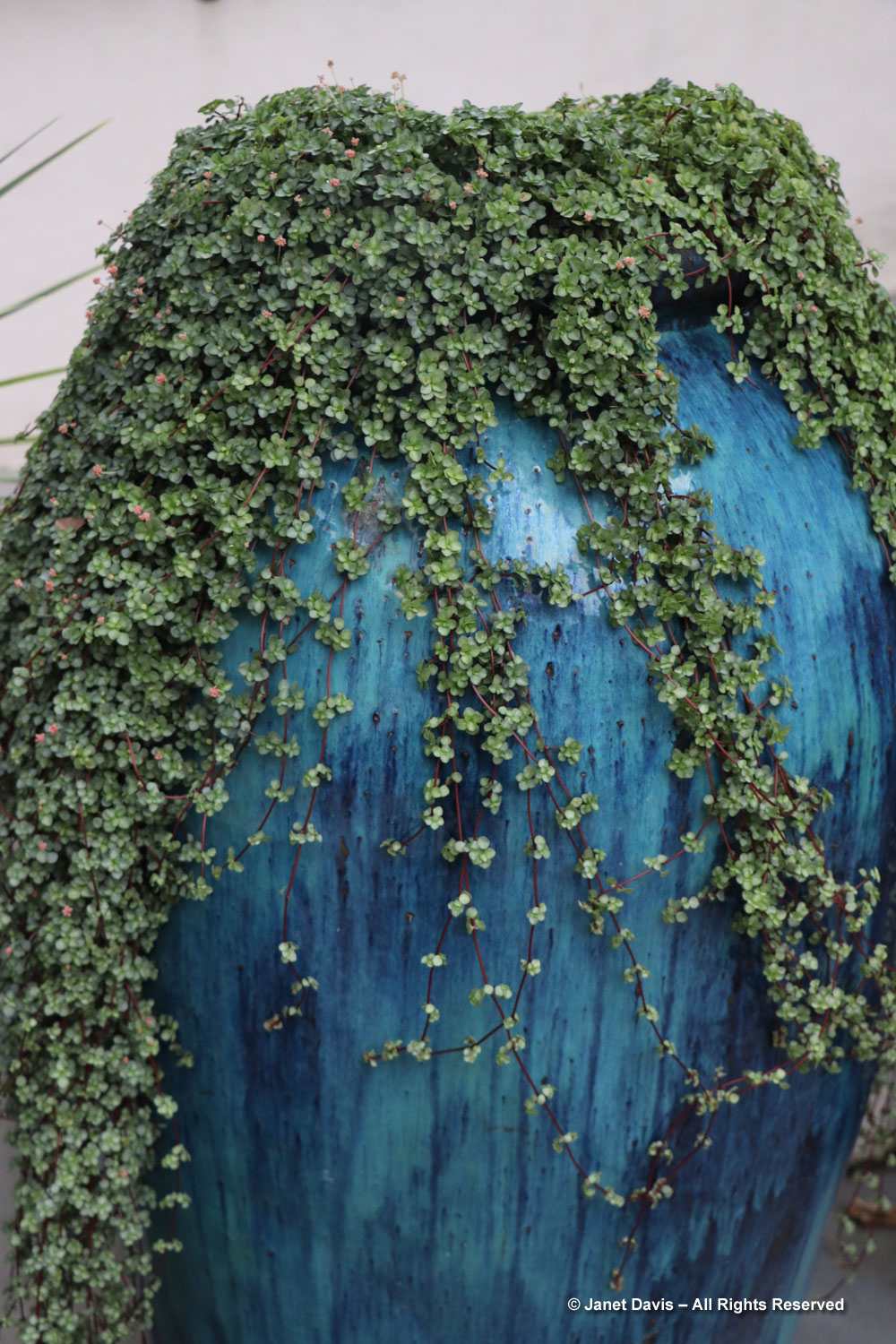
This triangular container grouping contains several types of lavender and a tall marigold, Tagetes ‘Garland Orange’, among other plants.
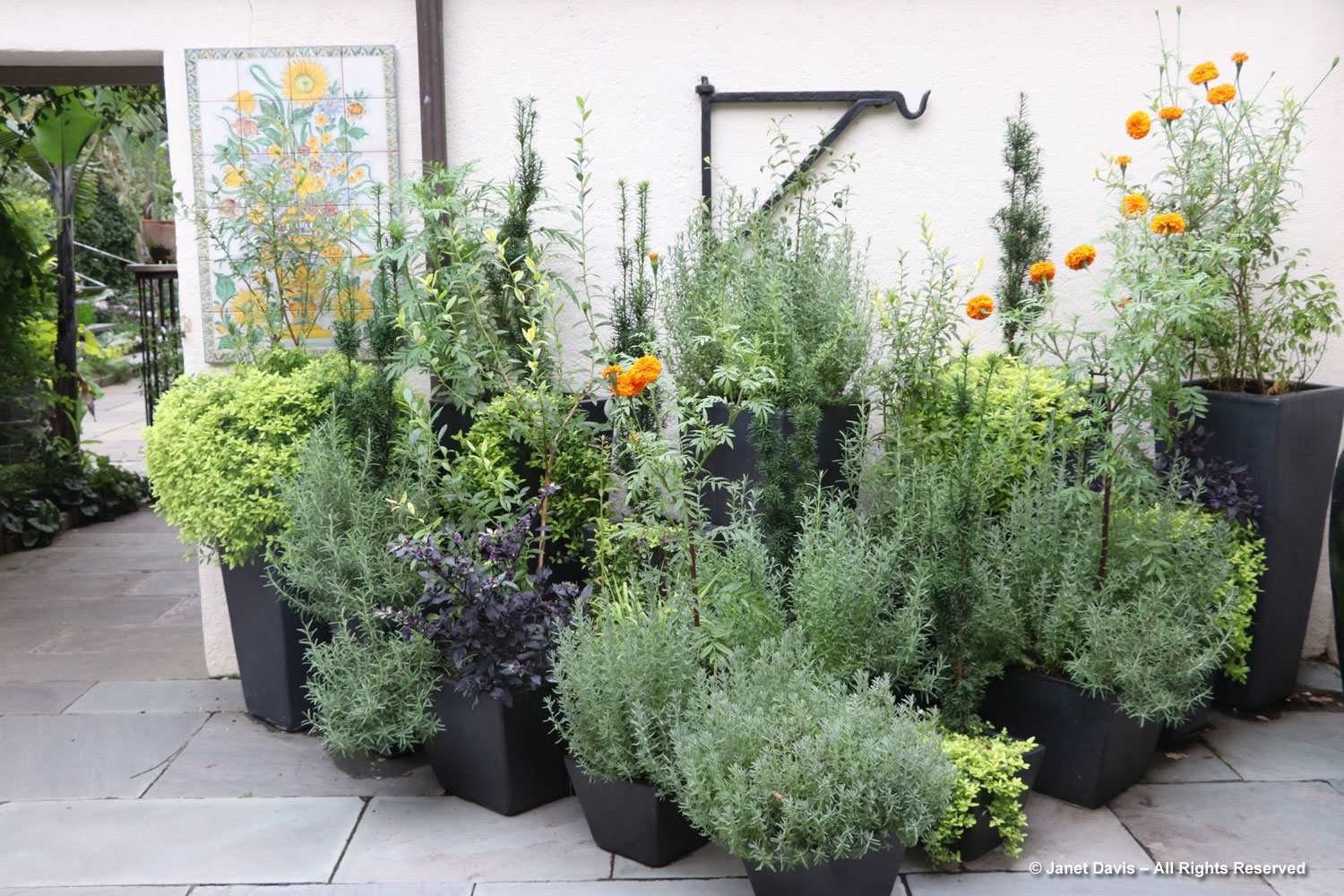
Attention to detail is a hallmark of Chanticleer, as evidenced by the small, elegant touches like bouquets placed here and there, including in the Ladies’ Room adjacent to the Teacup Garden.
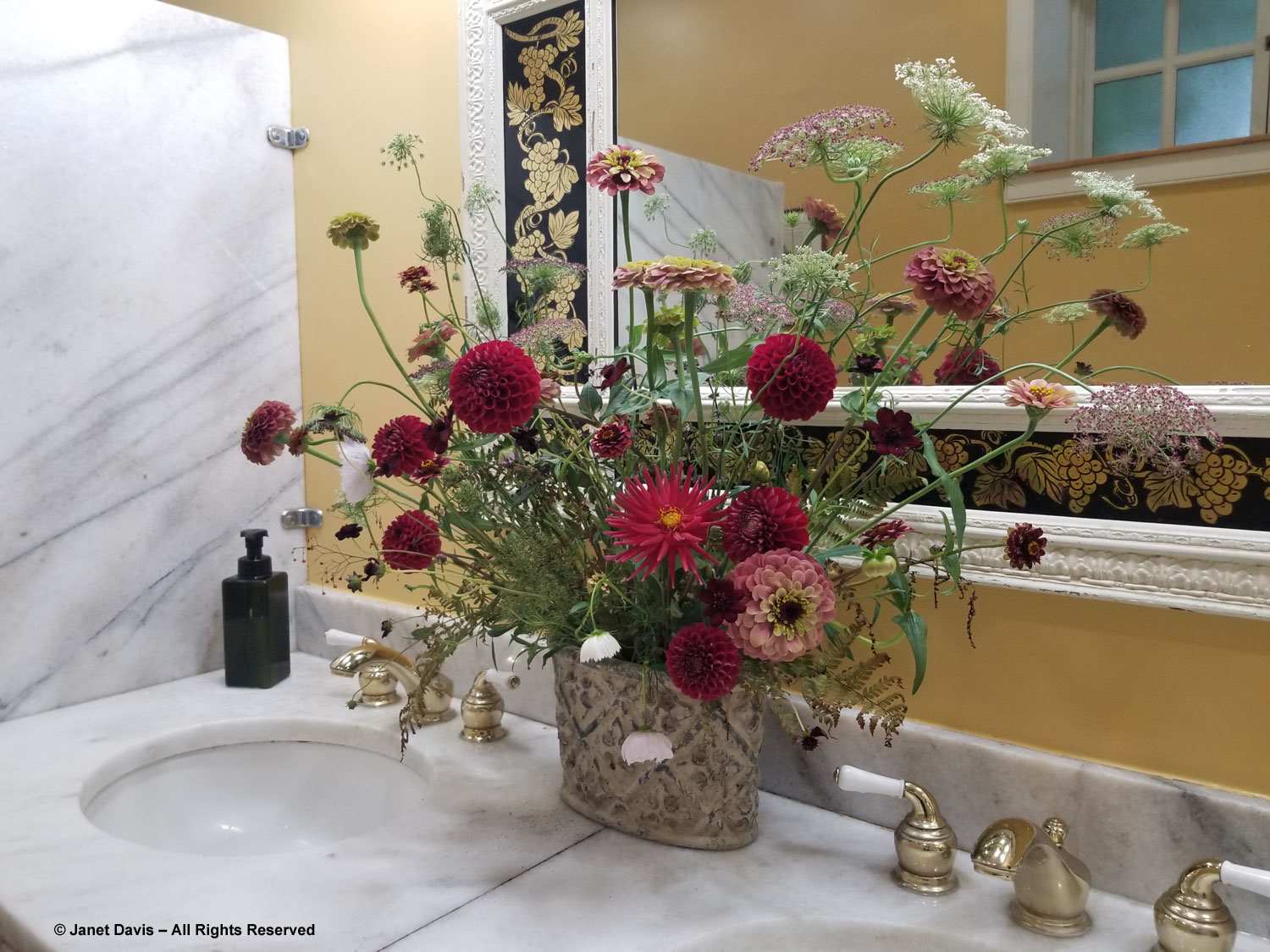
I took a quick look in the Upper Border characterized by its white flower palette and noted a handsome Texas Star hibiscus (H. coccineus ‘Albus’). But there wasn’t enough time to tarry here, and having visited Chanticleer before, I knew how to budget the few hours I had.
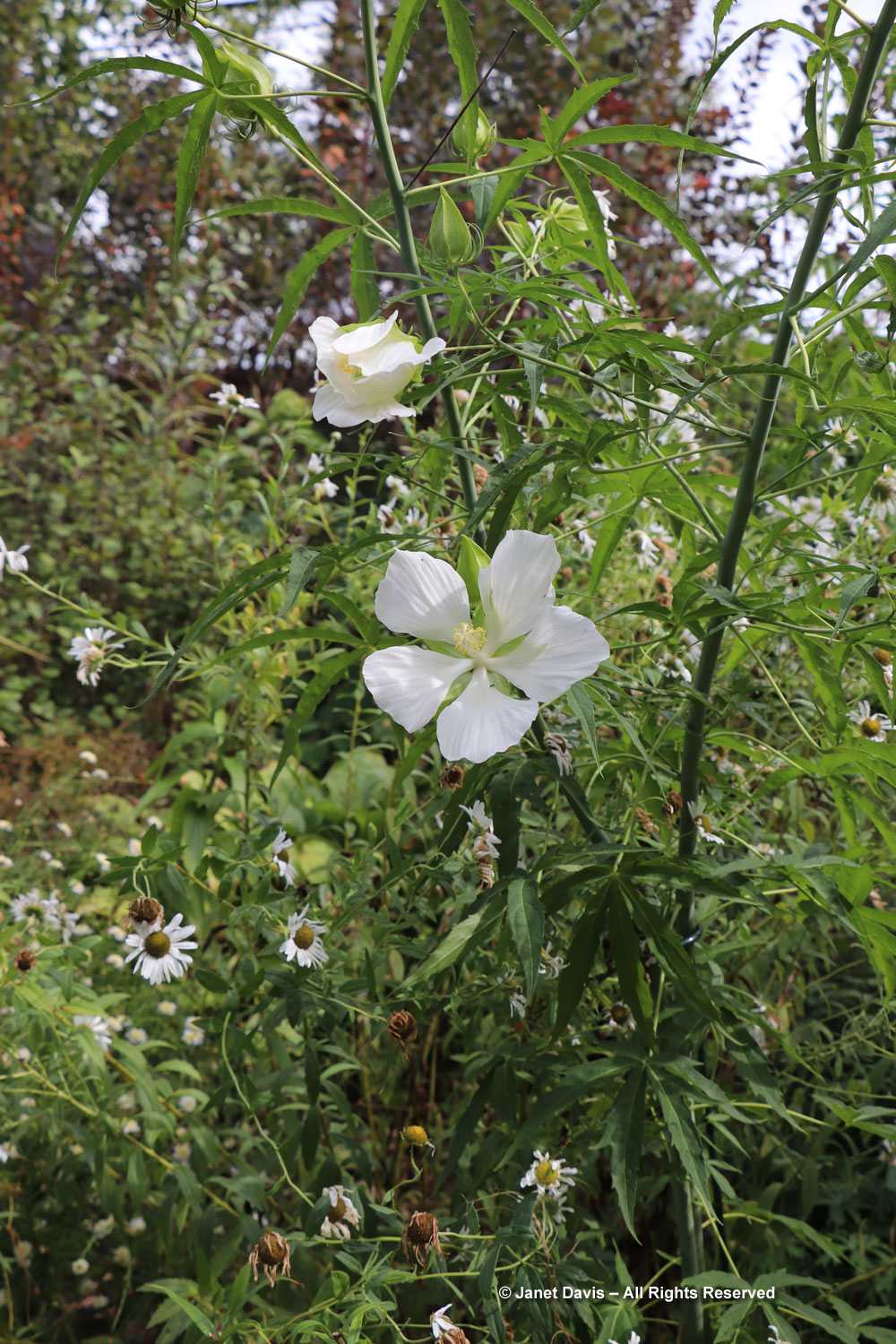
So off I went to the Tennis Court Garden below, named for the Rosengarten era but now converted into a garden of sweeping borders with a viewing arbor to take it all in. That yew on the left is Taxus ‘Beanpole’ – an apt name – and on the right, elegant ‘Honorine Jobert’ Japanese anemones. The echinacea is ‘Green Jewel’.
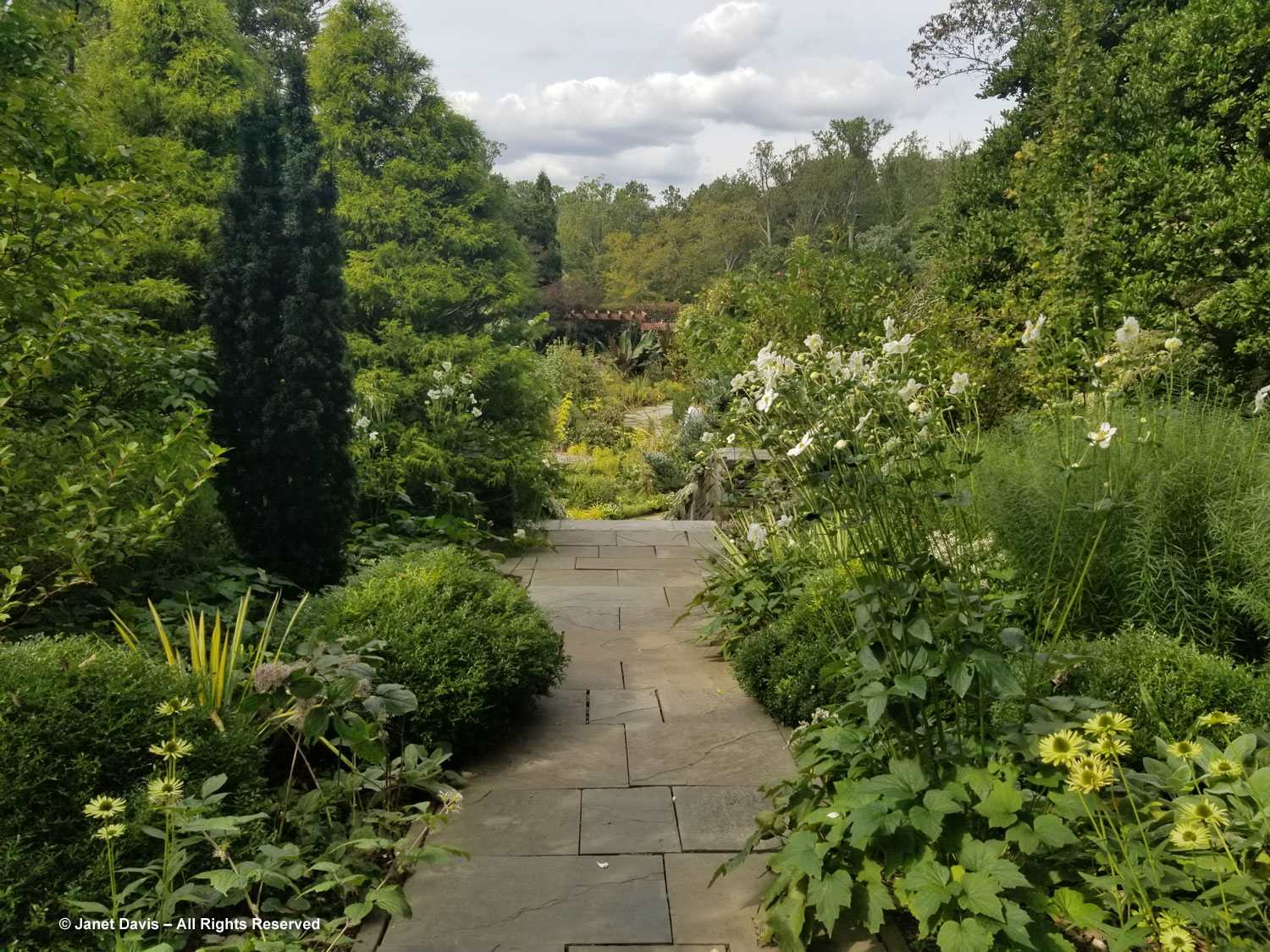
The stairs to the garden are one of my favourite design touches, with their built in planters. This year they contain gorgeous white Symphyotrichum ericoides ‘Snow Flurry’, dawn redwood (Metasequoia glyptostroboides), Lantana camara ‘Samantha’ and Sedum rupestre ‘Angelina’.
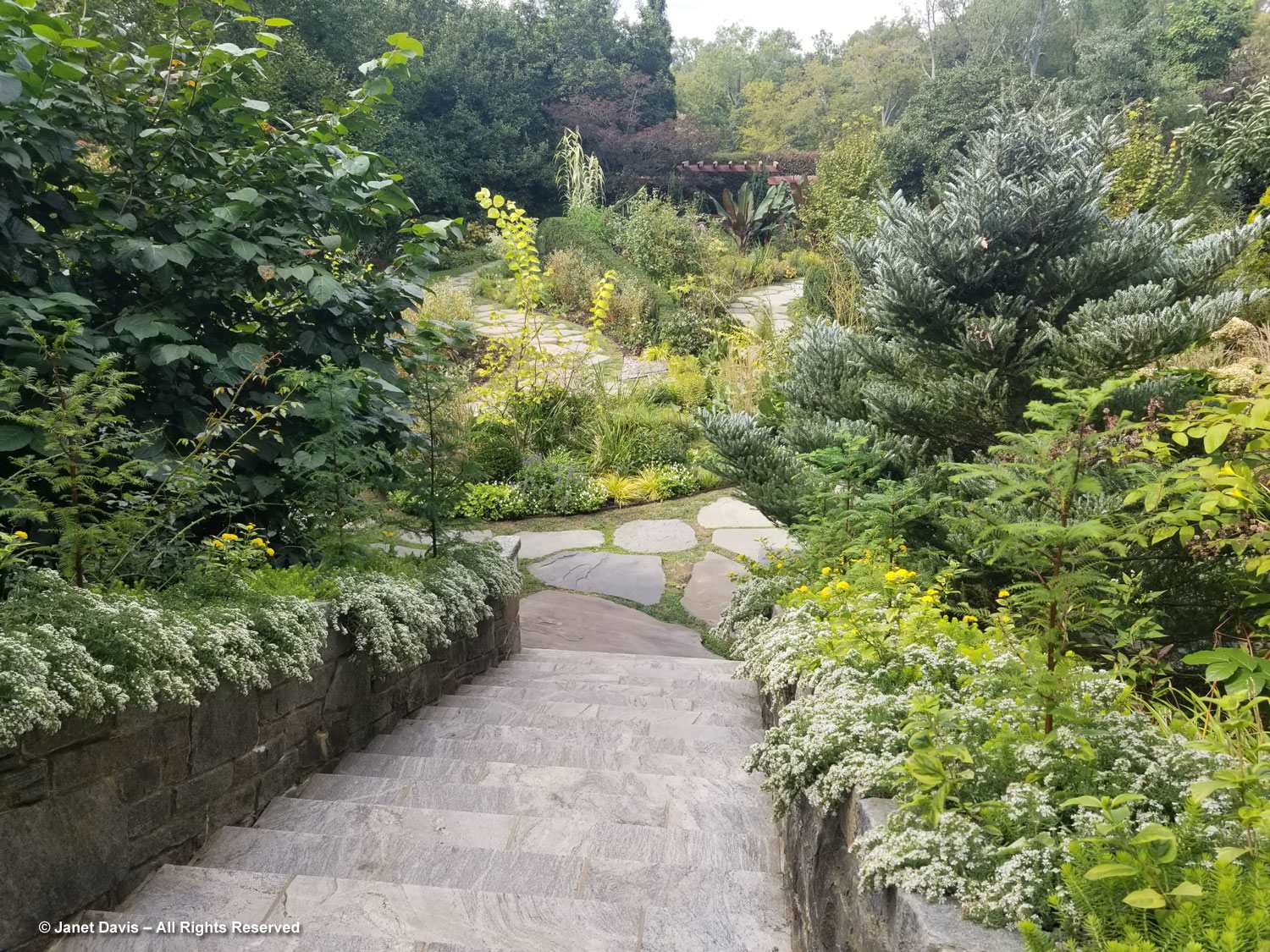
Who would ever think about punctuating a linear planter with tiny dawn redwoods? Or, put another way, why not use your nursery plants as decorative flourishes?
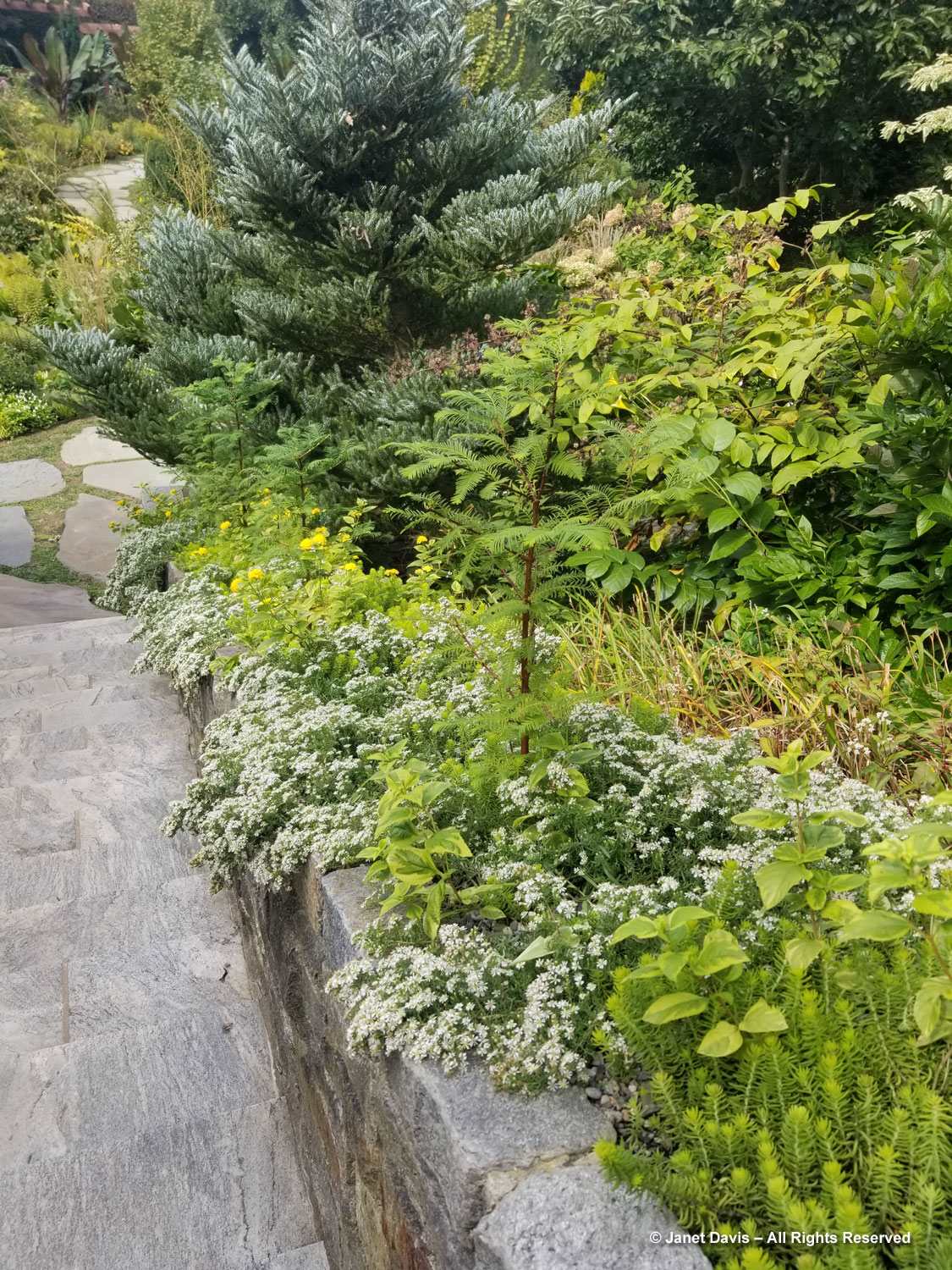
The old tennis court is planted with lush, curved borders.
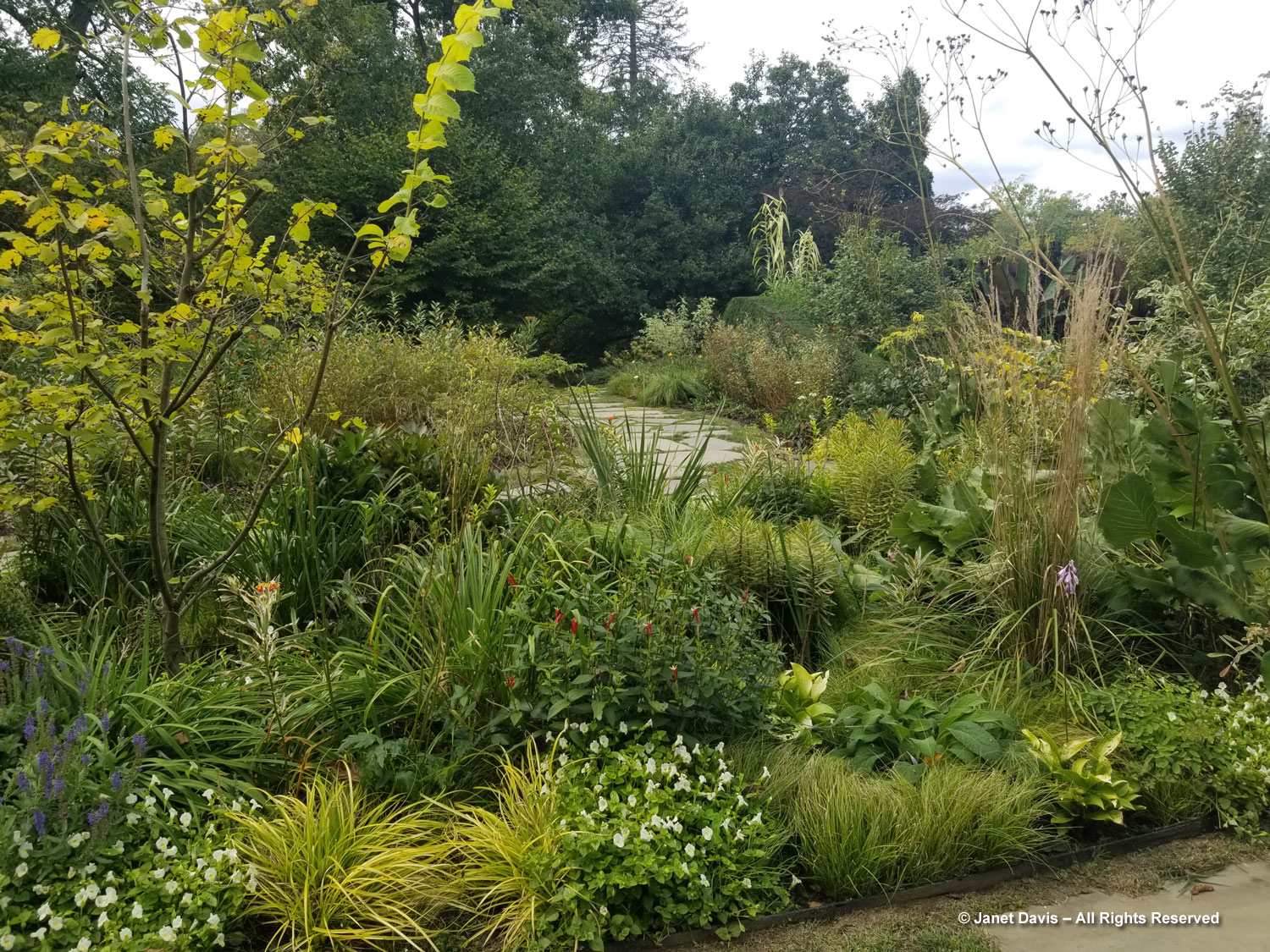
Despite reading praises about this late-flowering perennial, I had never before seen it. Meet Letterman’s ironweed, Vernonia lettermanii ‘Iron Butterfly’. The edging is Heuchera ‘Caramel’.
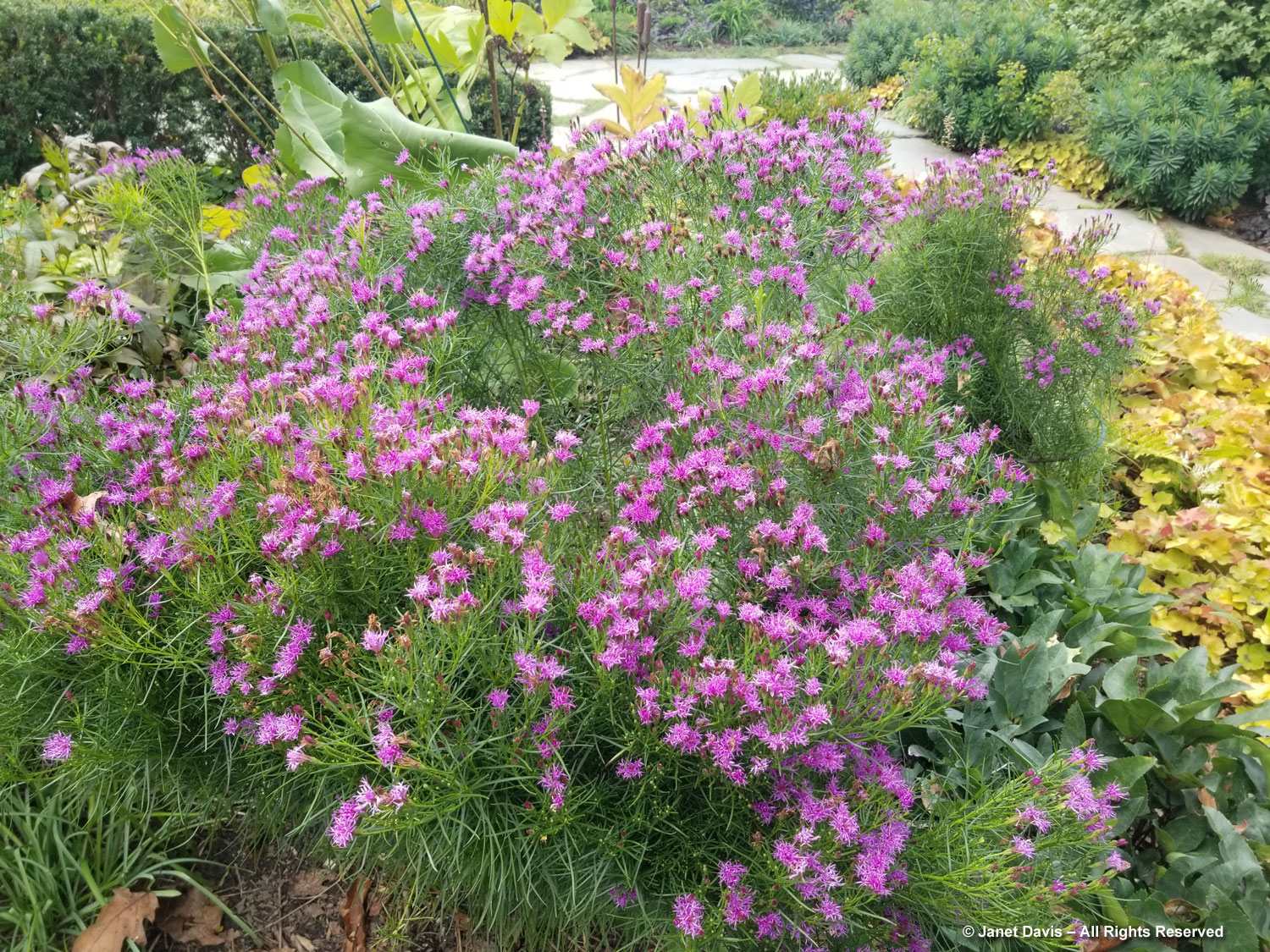
I loved this combination of lilac aster (possibly Symphyotrichum ericoides ‘Blue Star’?) with Succisella inflexa ‘Frosted Pearls’, aka devil’s bit.
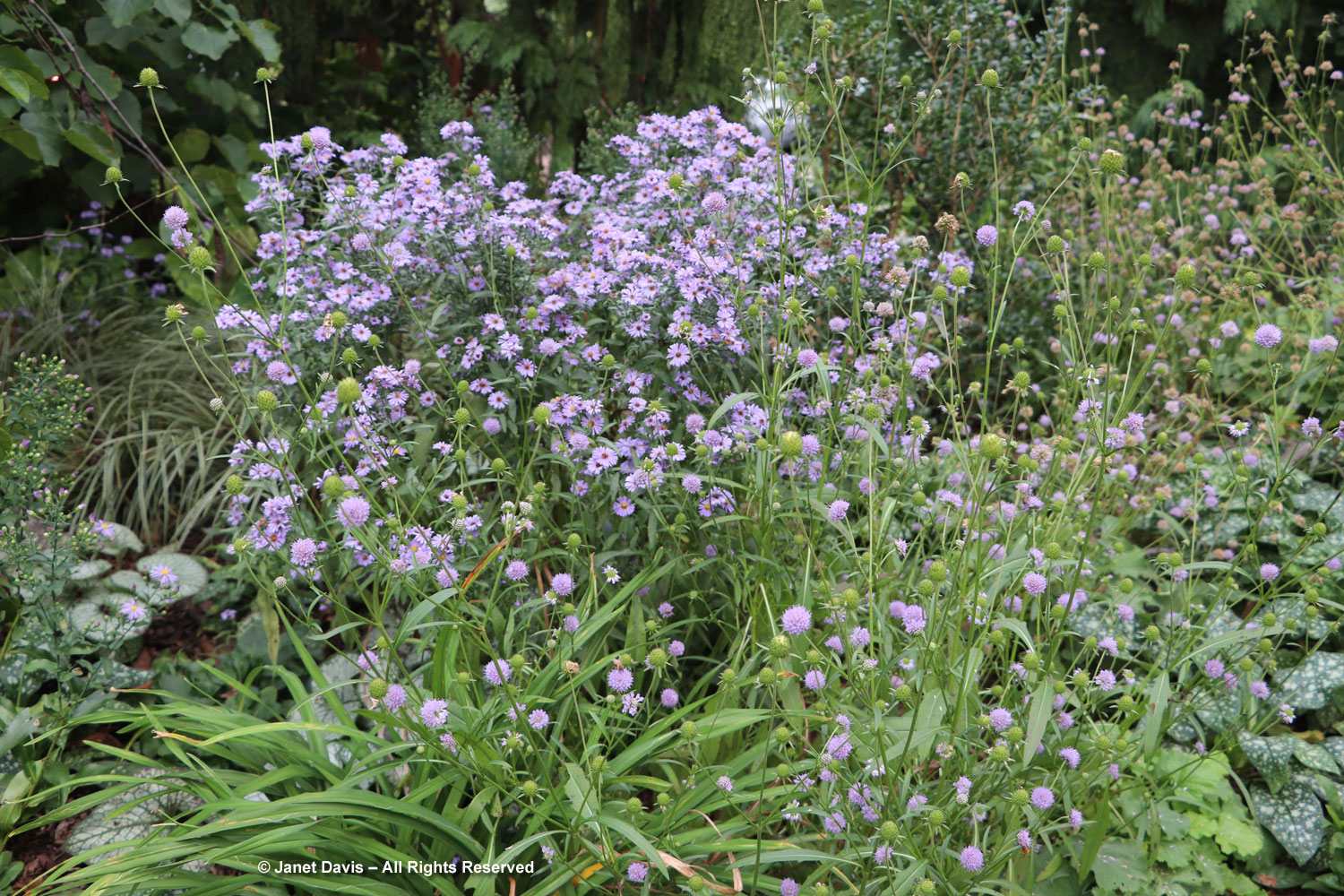
The bumble bees were enjoying the knautia-like heads of the flowers.
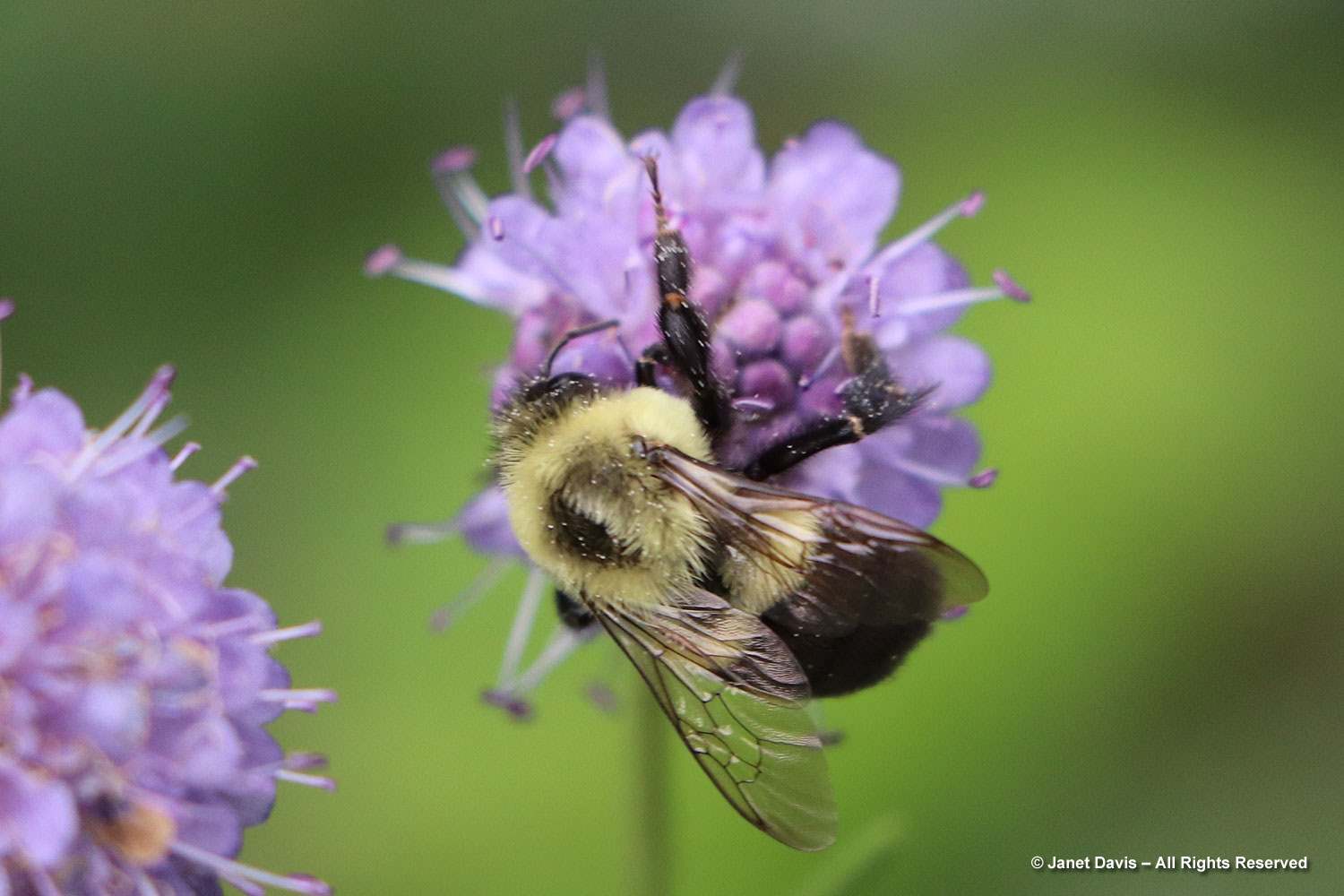
The nearby Cutting Garden is a place of chaotic loveliness in late September. Its central path covered with pinestraw leads to the fenced Vegetable Garden.
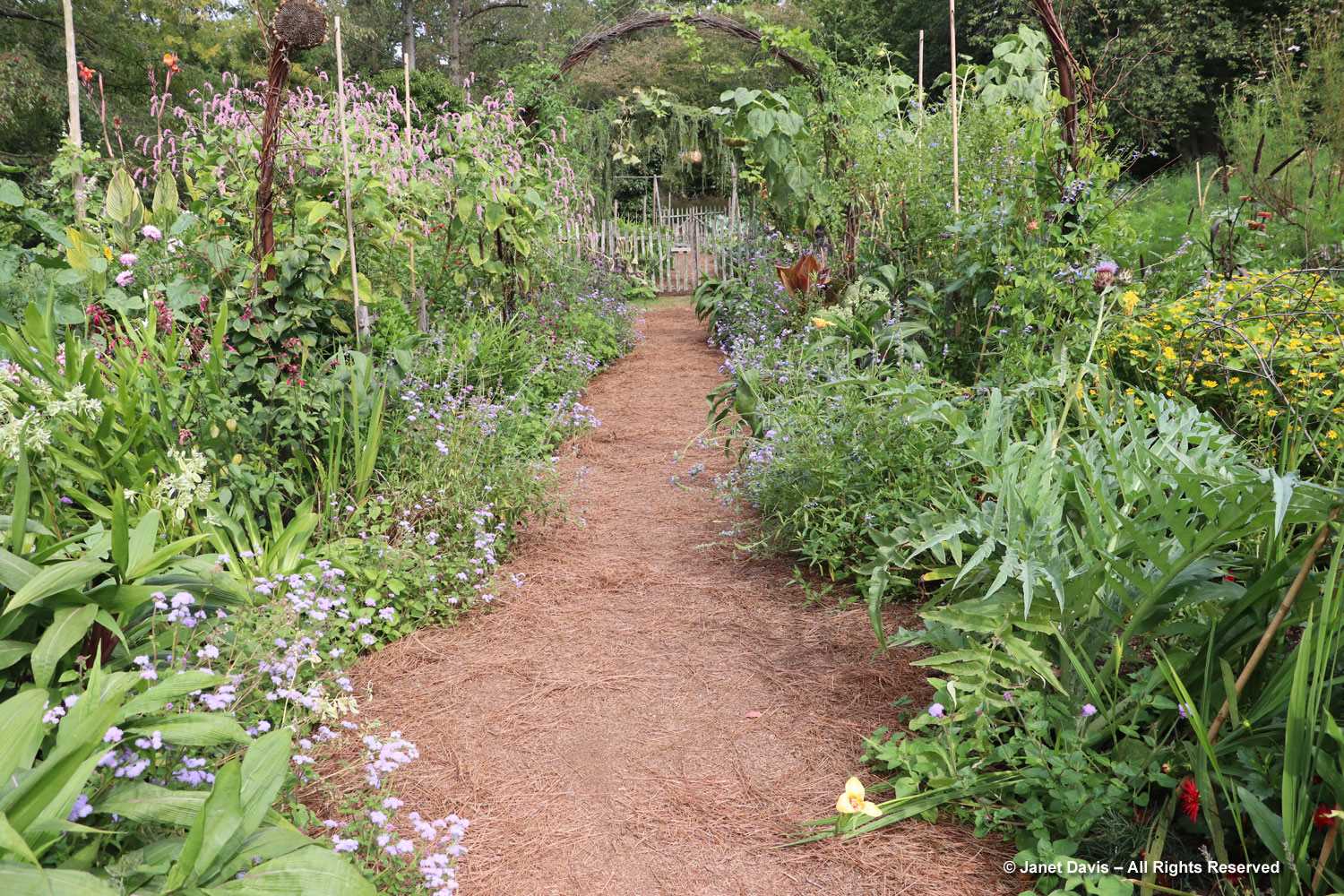
There are annuals, perennials, tender bulbs and even the odd staked cherry tomato in the Cutting Garden. Plus, of course, all the flowers used in Chanticleer’s season-long floral arrangements. That dark-headed grass is Pennisetum glaucum ‘Jade Princess’.
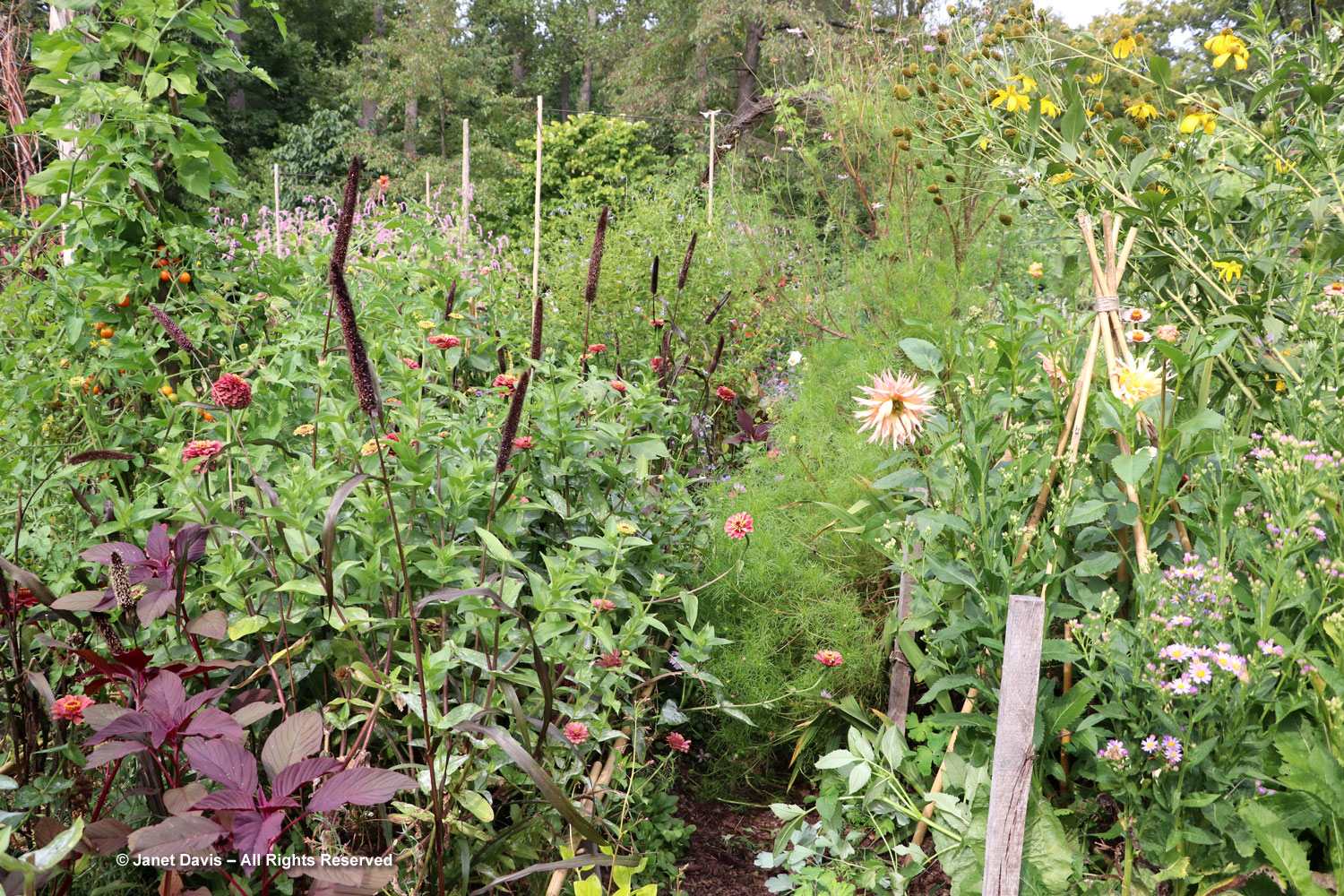
The dark red plant near the cosmos and ageratum is cranberry hibiscus (Hibiscus acetosella). It makes a luscious foliage filler in floral arrangements.
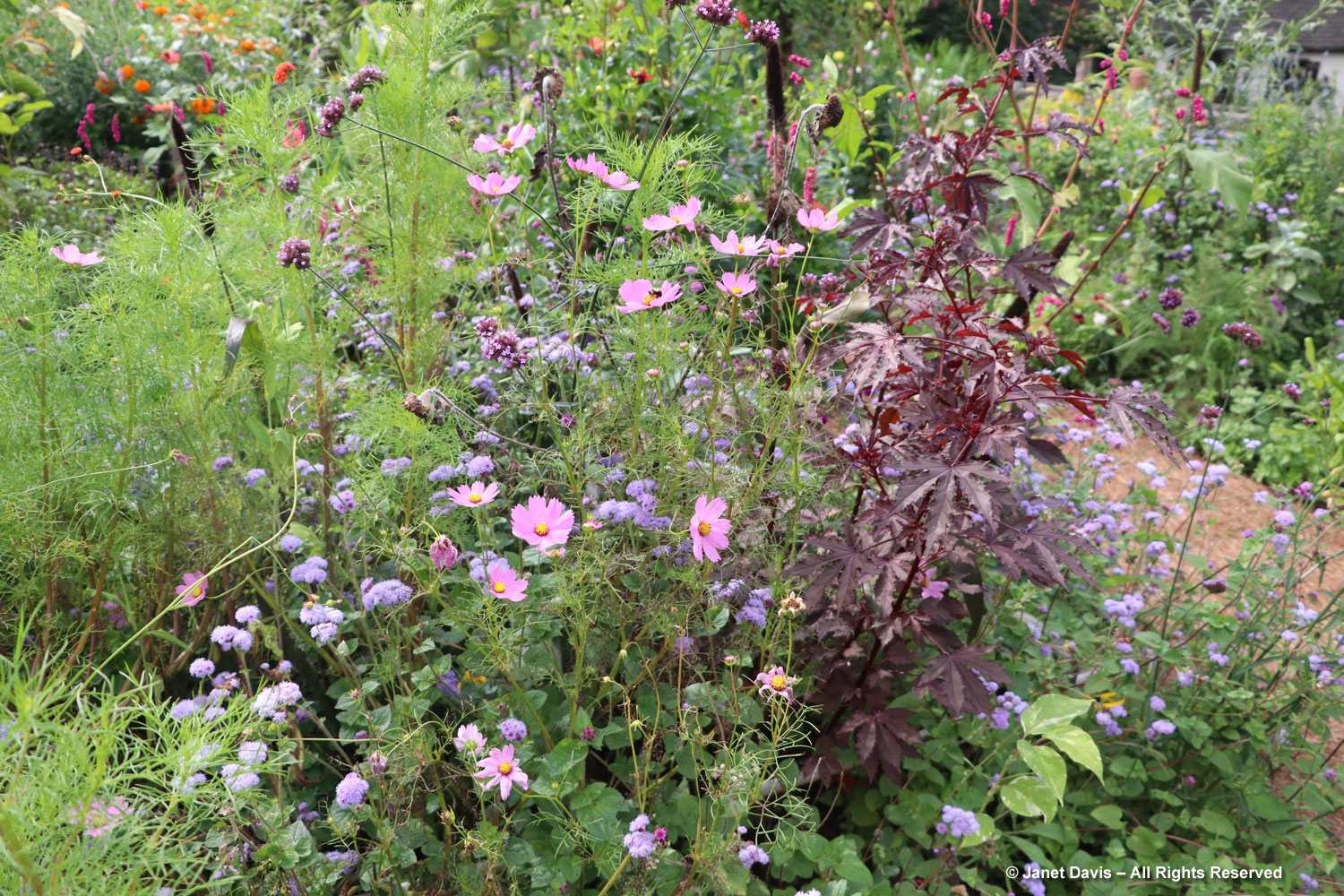
That towering yellow daisy in the back is willowleaf sunflower (Helianthus salicifolius).
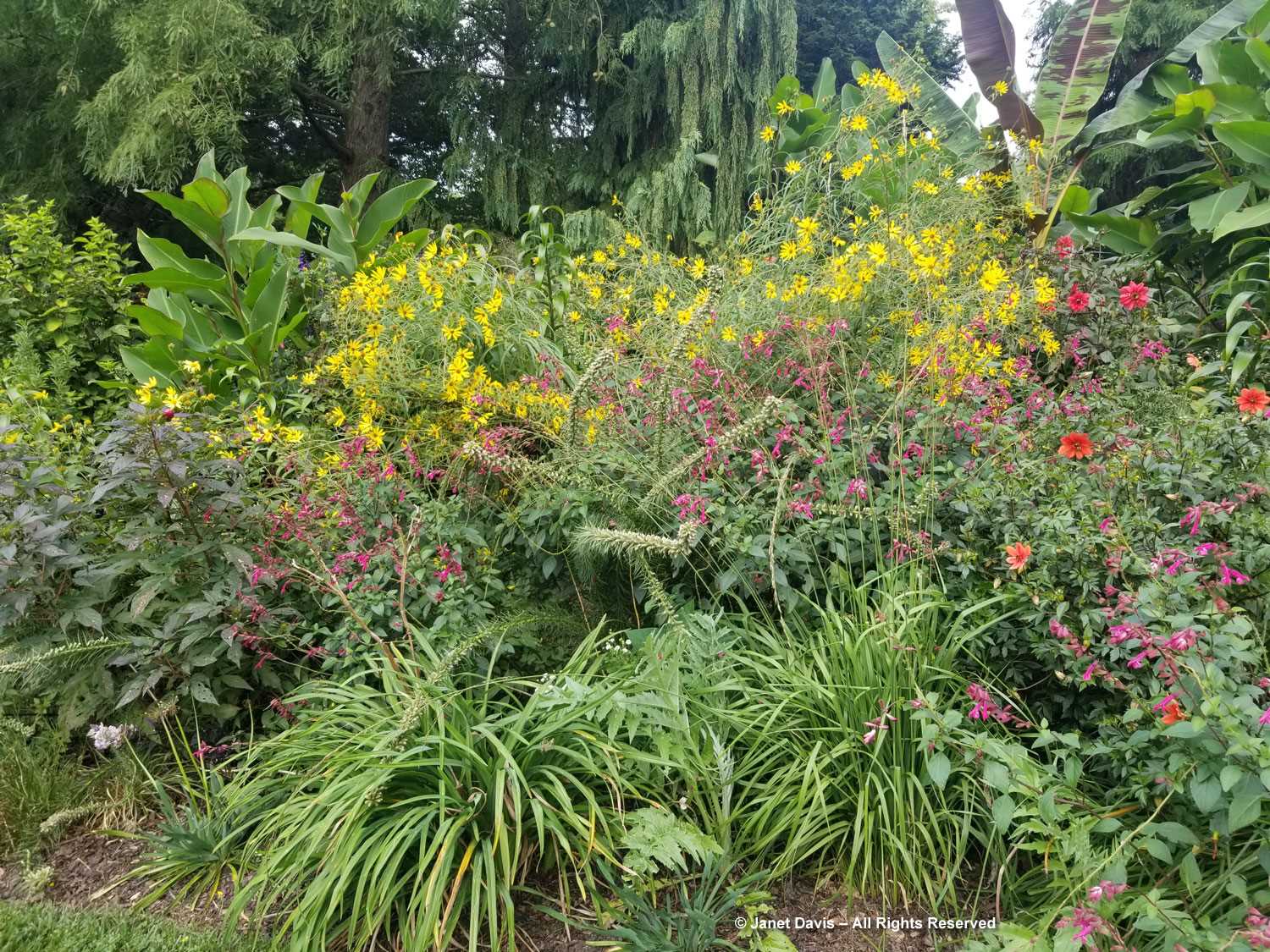
Have you ever seen a more beautiful dahlia? It’s called ‘Harvey Koop’, and I spotted it later in a bouquet.
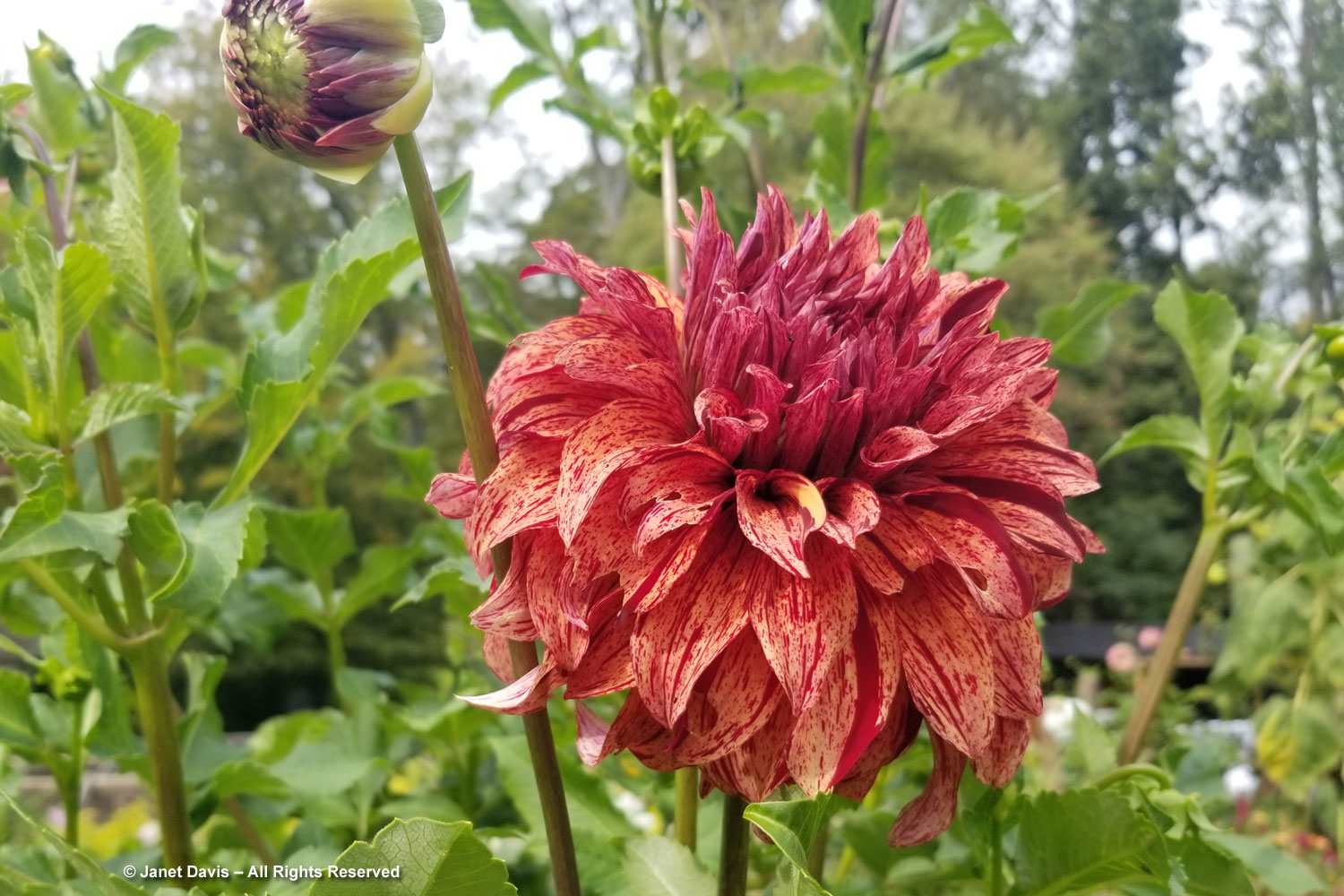
One could spend hours in Bell’s Run exploring the woodland jewels, then strolling through the Creek Garden with its moisture-loving plants, but I wanted to focus on the flowering jewels of late summer, so after a quick walk along the lovely creek….
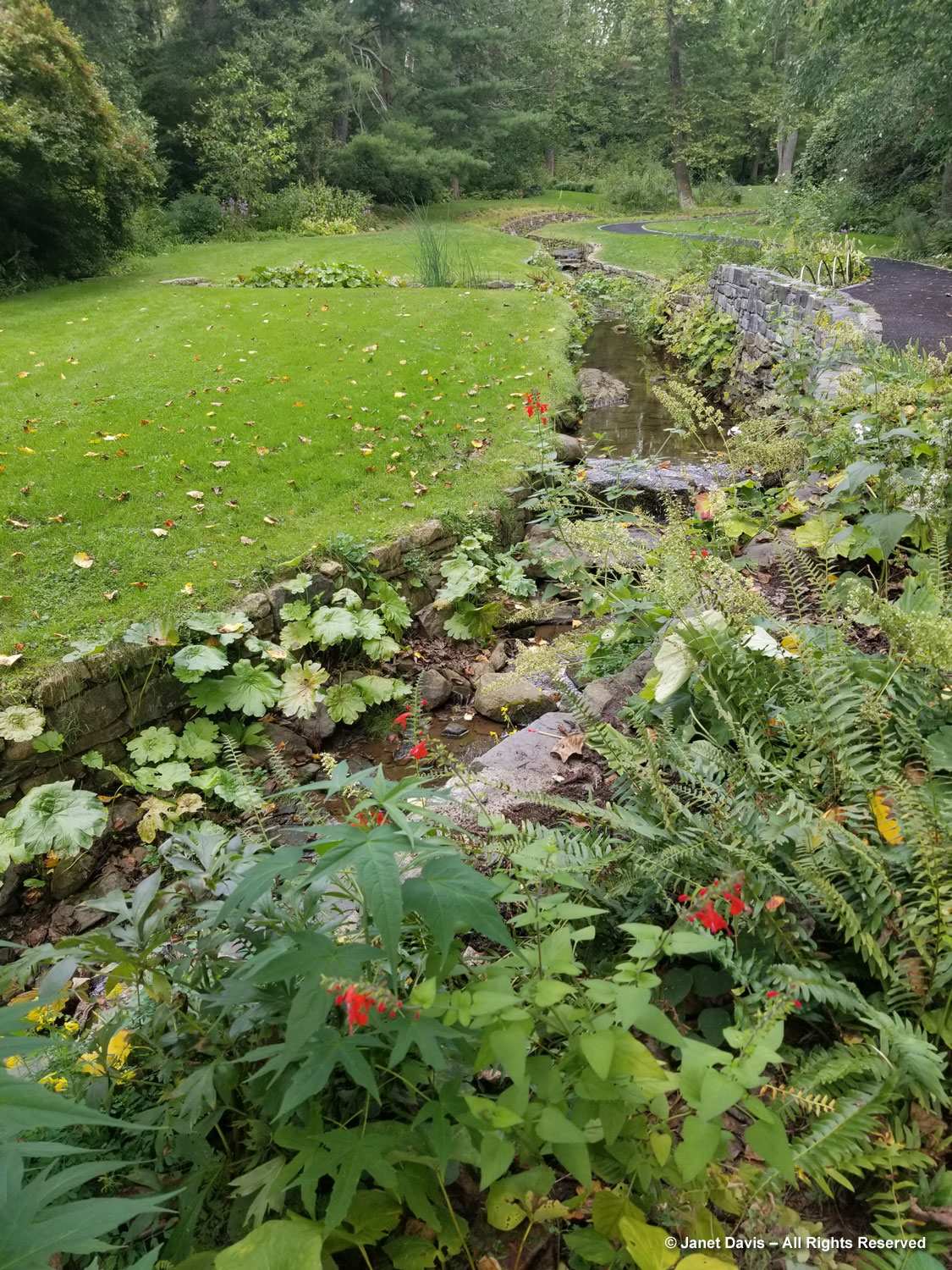
…. I came back to the light in the Ruin Garden’s sporobolus meadow (S. heterolepis) with its flanking hydrangeas (H. paniculata).
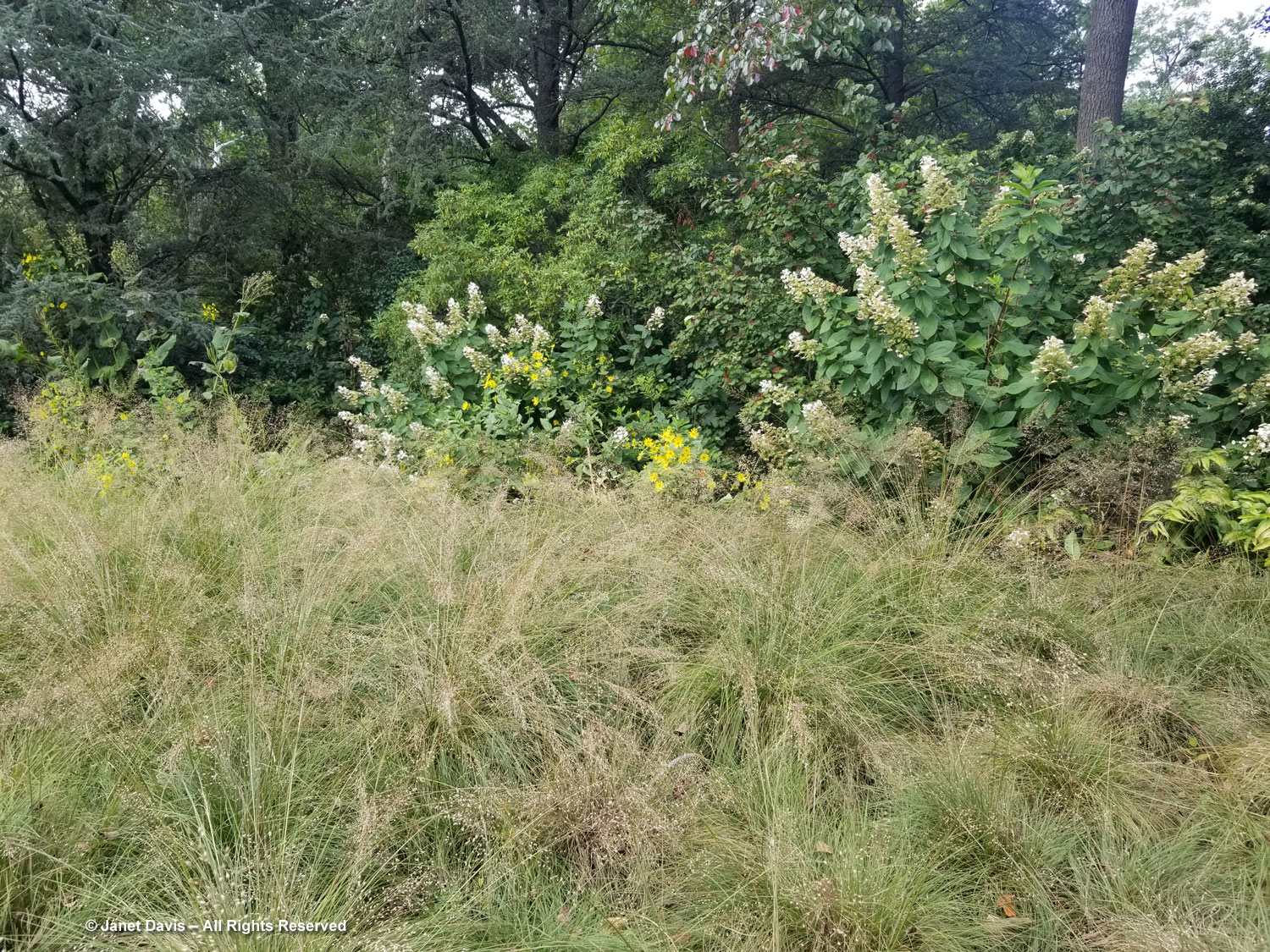
On the way to the ponds, I stopped in at the Arbor and took a moment to appreciate gardener Dan Benarcik’s distinctive “Chanticleer chairs” and the lime-green Carex oshimensis ‘Evercolor Everillo’ in the pots.
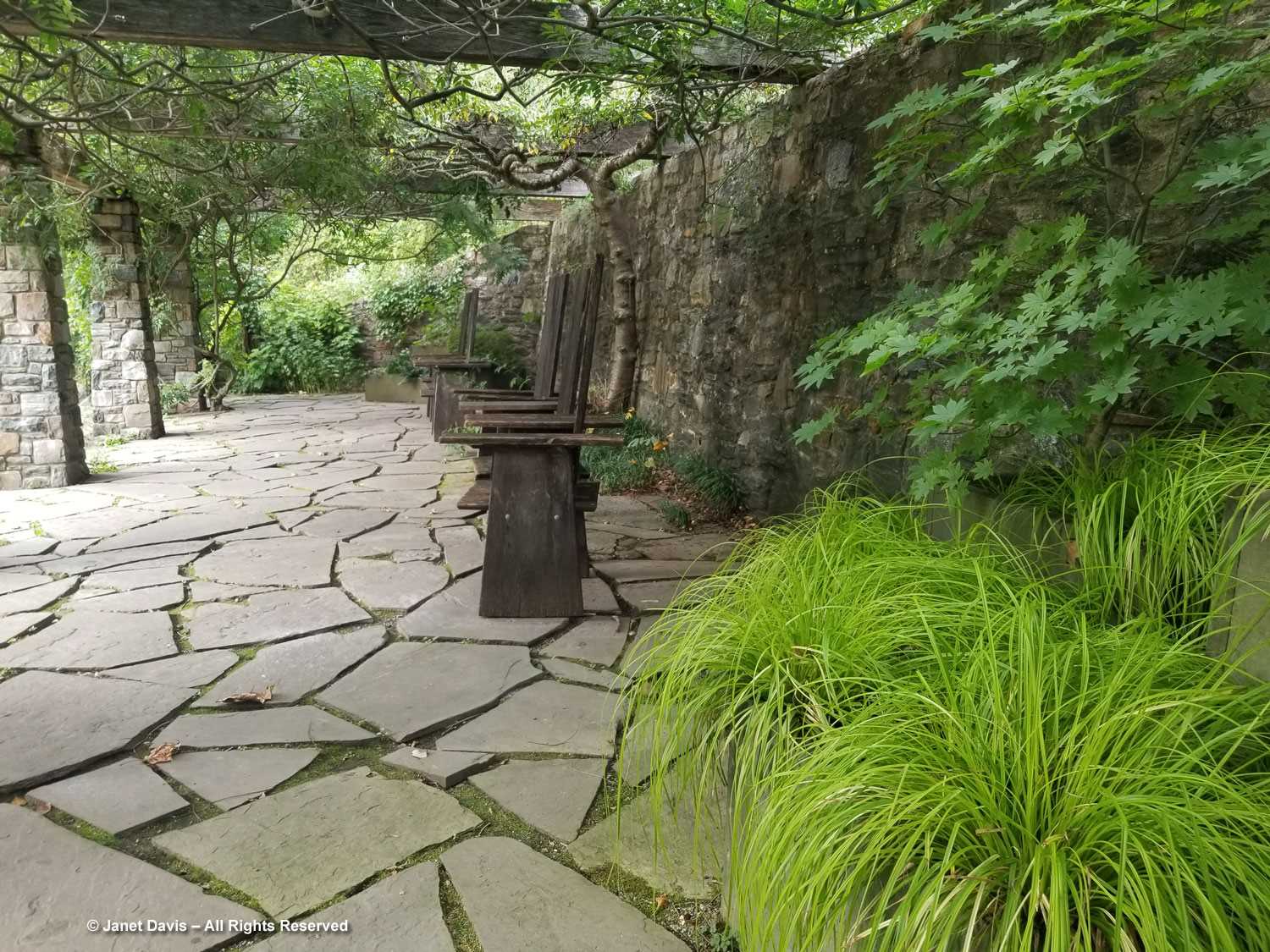
Then I walked past the Silver Garden with its yellow Sternbergia lutea, one of the finest autumn-flowering bulbs backed by a white aster.
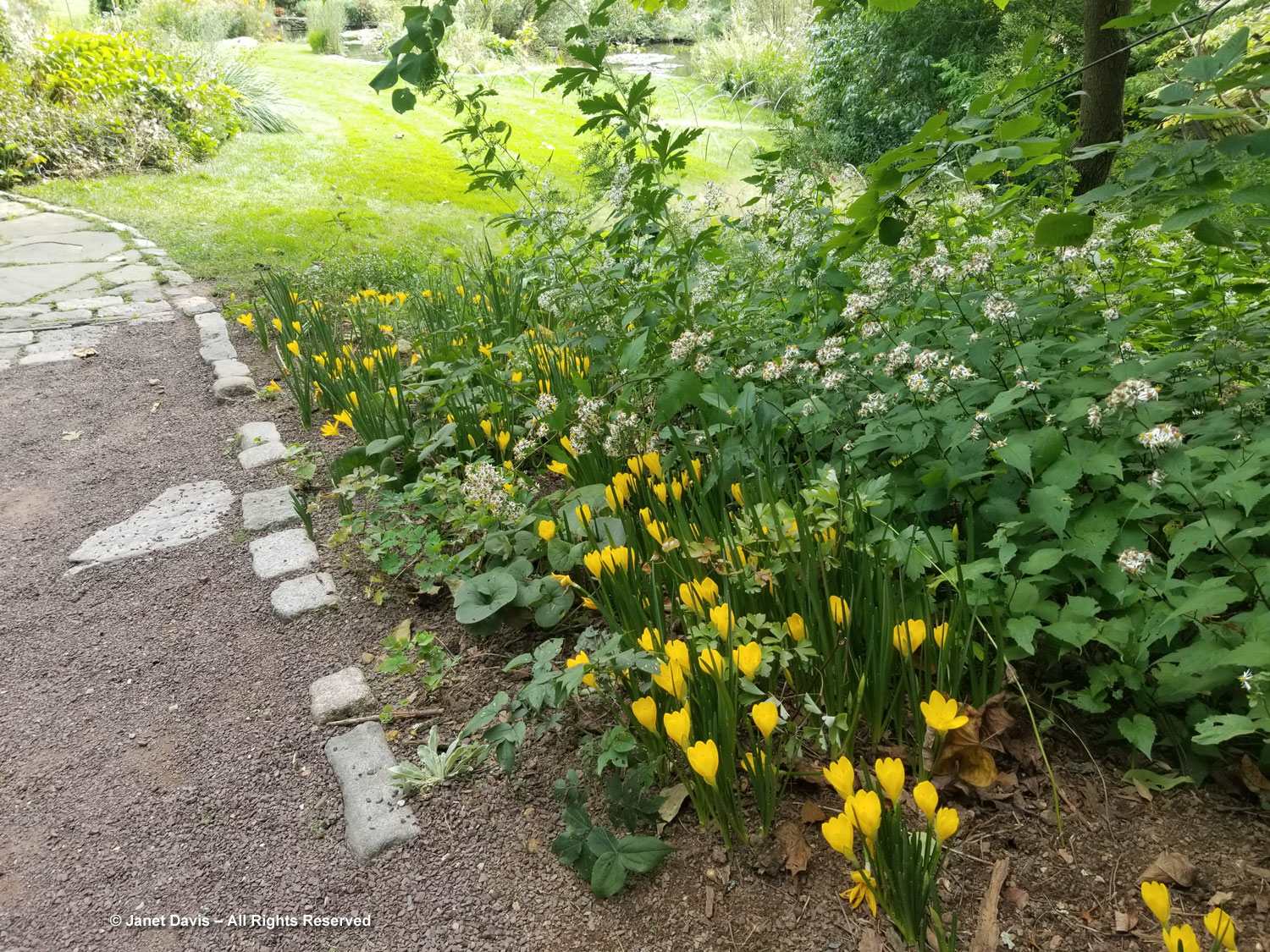
The ponds are always a favourite destination before climbing back up the hill at Chanticleer. This one features a ledge waterfall. I believe the gold shrub is Chamaecyparis pisifera ‘Filifera Aurea Nana’.
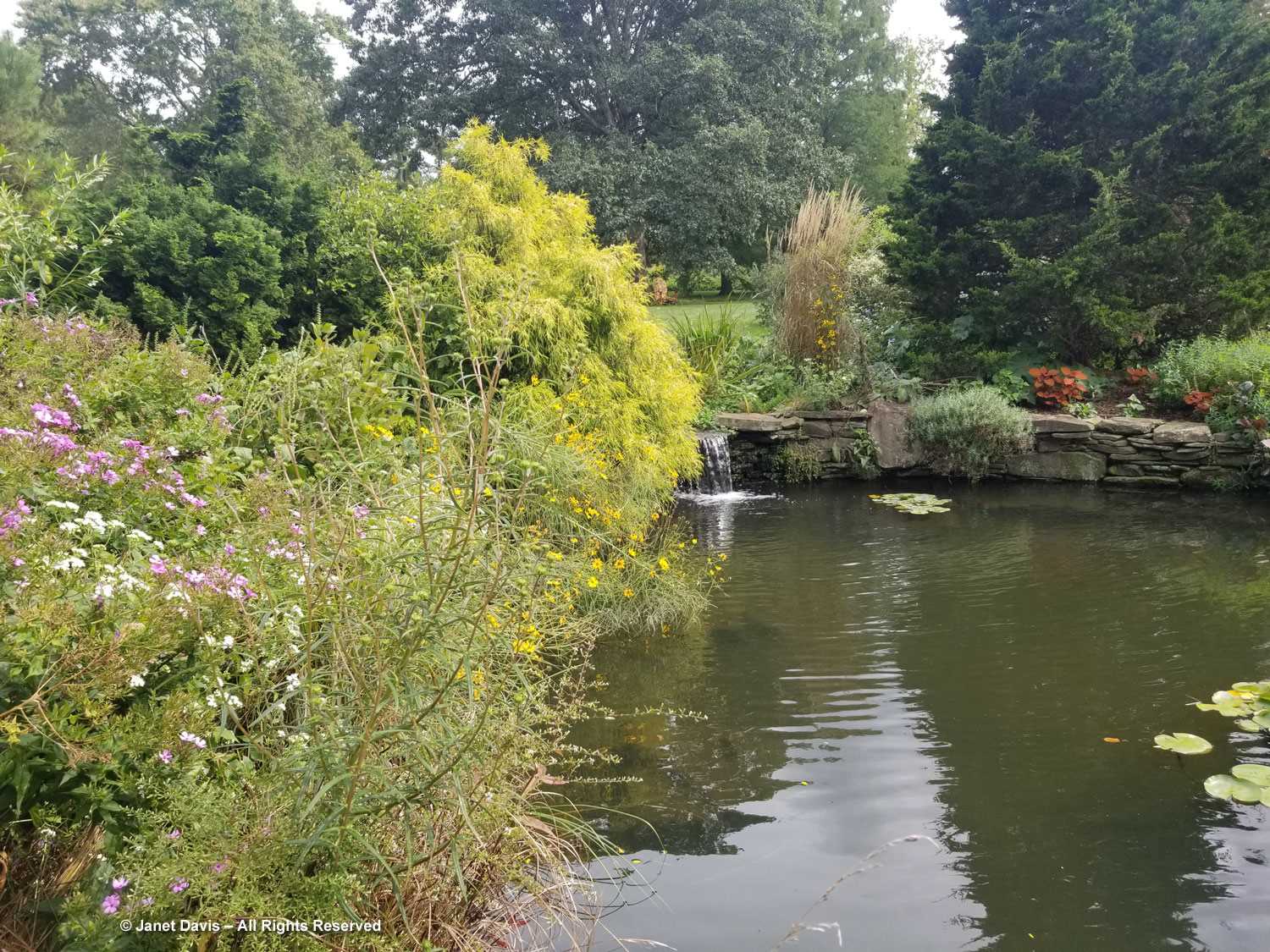
This pond hosts the white water lily Nymphaea ‘Pöstlingberg’.
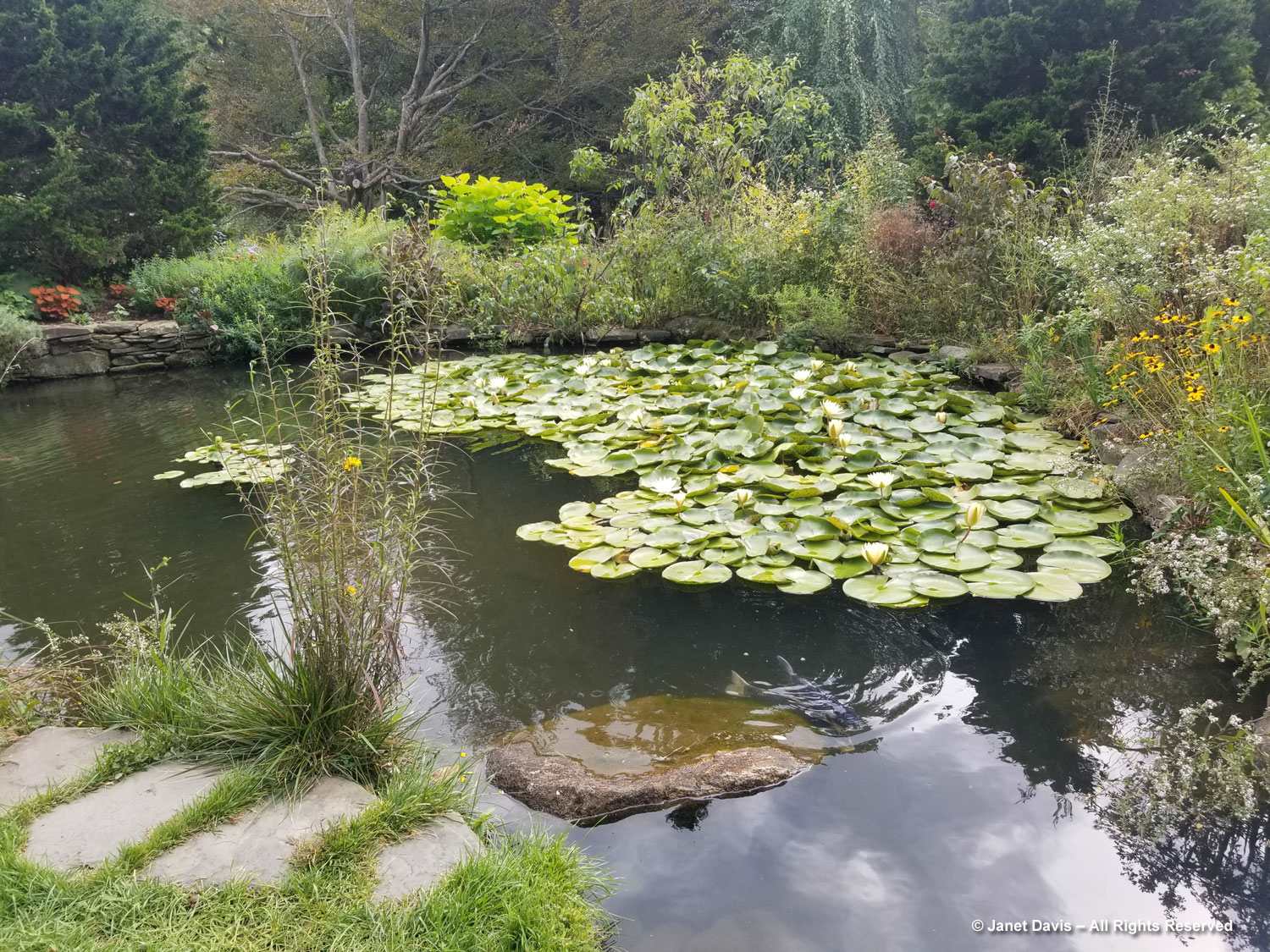
Marginal aquatic plants enjoy the edges of the ponds. The white-flowered plant below is Echinodorus bracteatus ‘Lantau Lady’, aka Amazon sword.
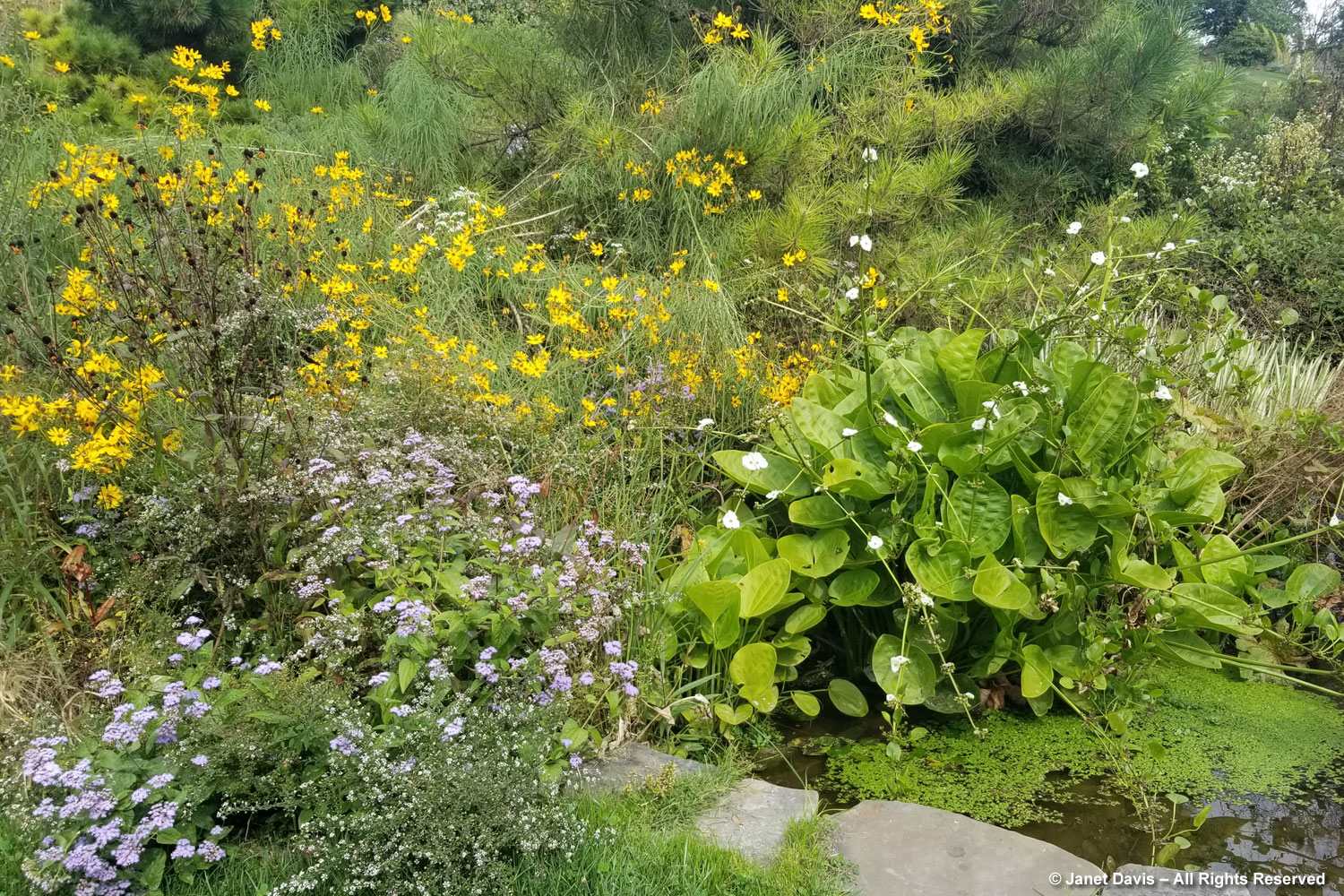
The big koi always look a little hungry, though they are certainly well-fed! But a little begging can’t hurt, right?
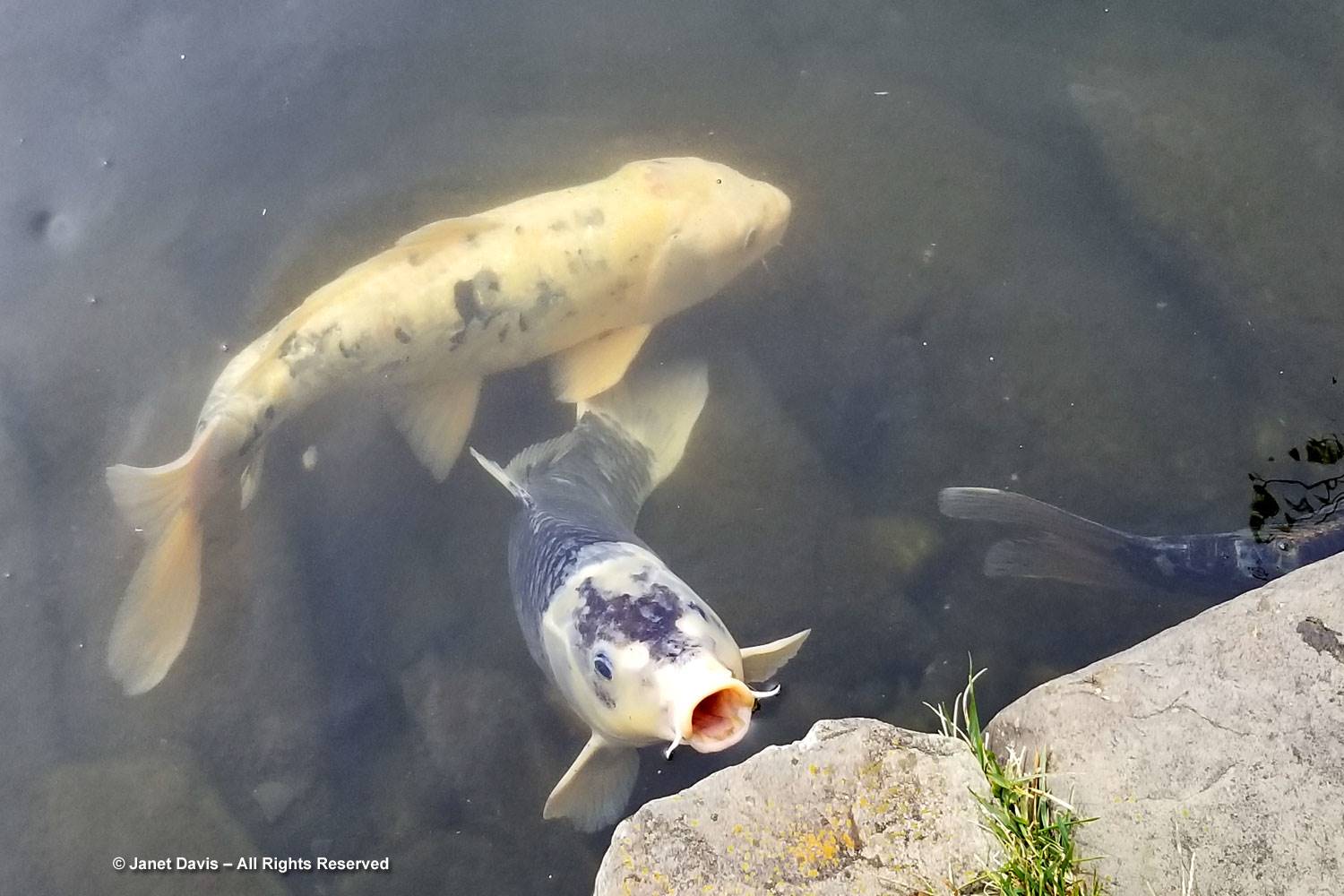
But look what surprise awaited me at one of the ponds! This handsome great blue heron might have dreamt of koi but the most he managed to catch was a frog, or so I learned later. And did you know there’s an aquatic version of rattlesnake master? It’s marsh rattlesnake master Eryngium aquaticum, an American native whose habitat includes bogs, swamps and marshes. Another name is bitter snakeroot, reflecting its use by Native Americans to treat snakebites. Its spiky inflorescences start out blue, then fade to whitish-gray.
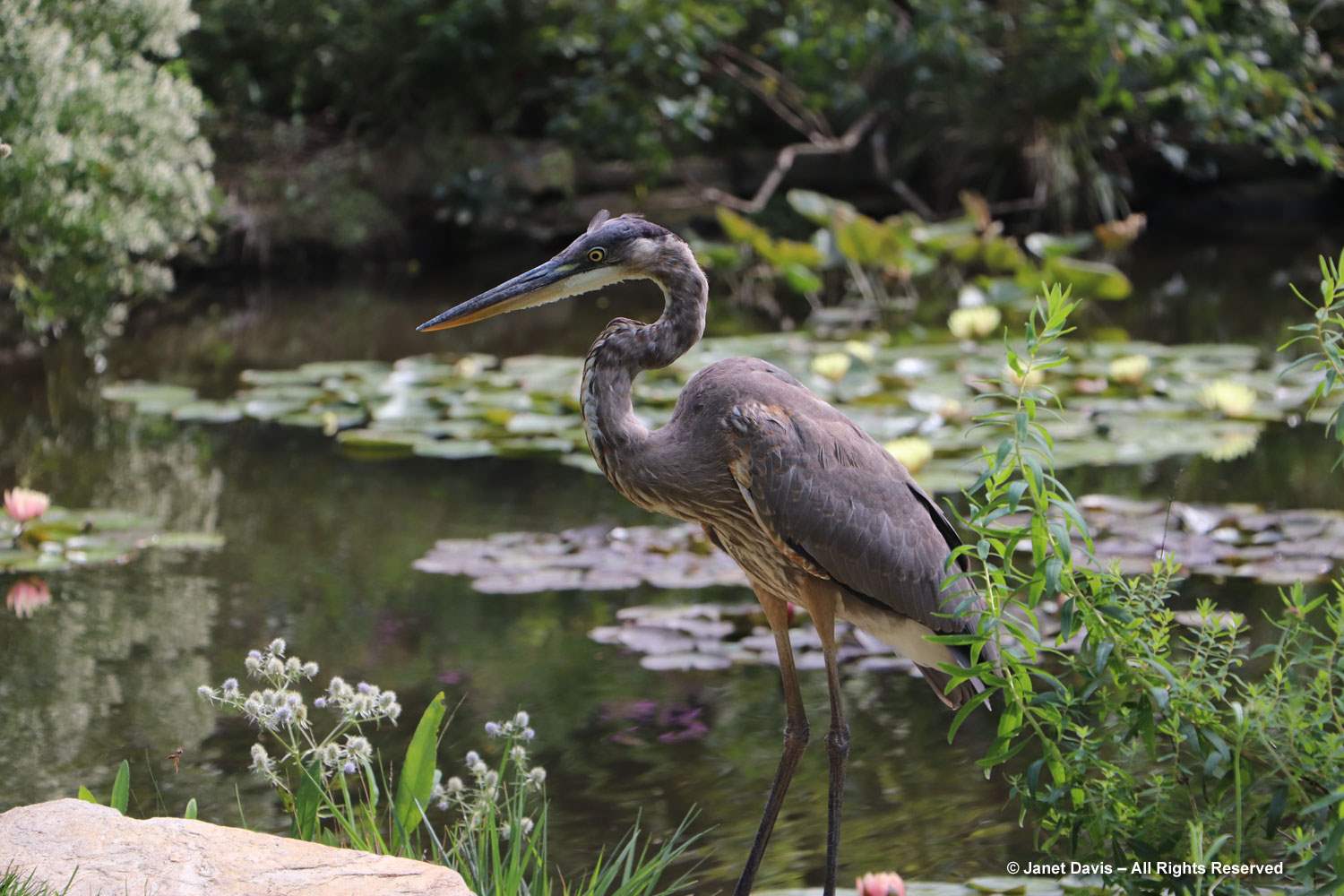
The heron seemed relatively unafraid of the visitors and moved around the pond while posing nicely, so I gave it a little more than its 15 photographic minutes of fame.
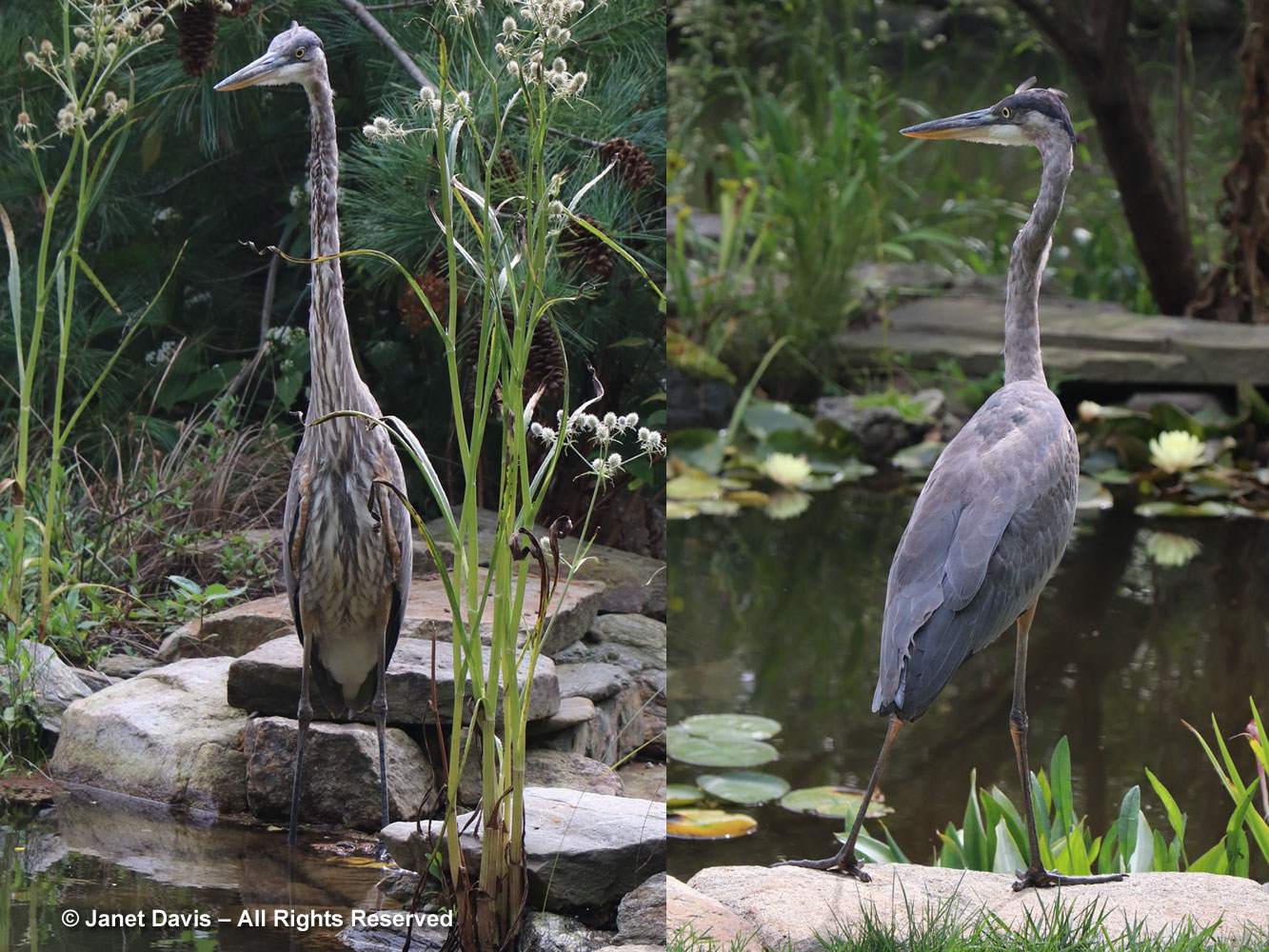
The waterlily in the heron pond is Nymphaea ‘Texas Dawn’.
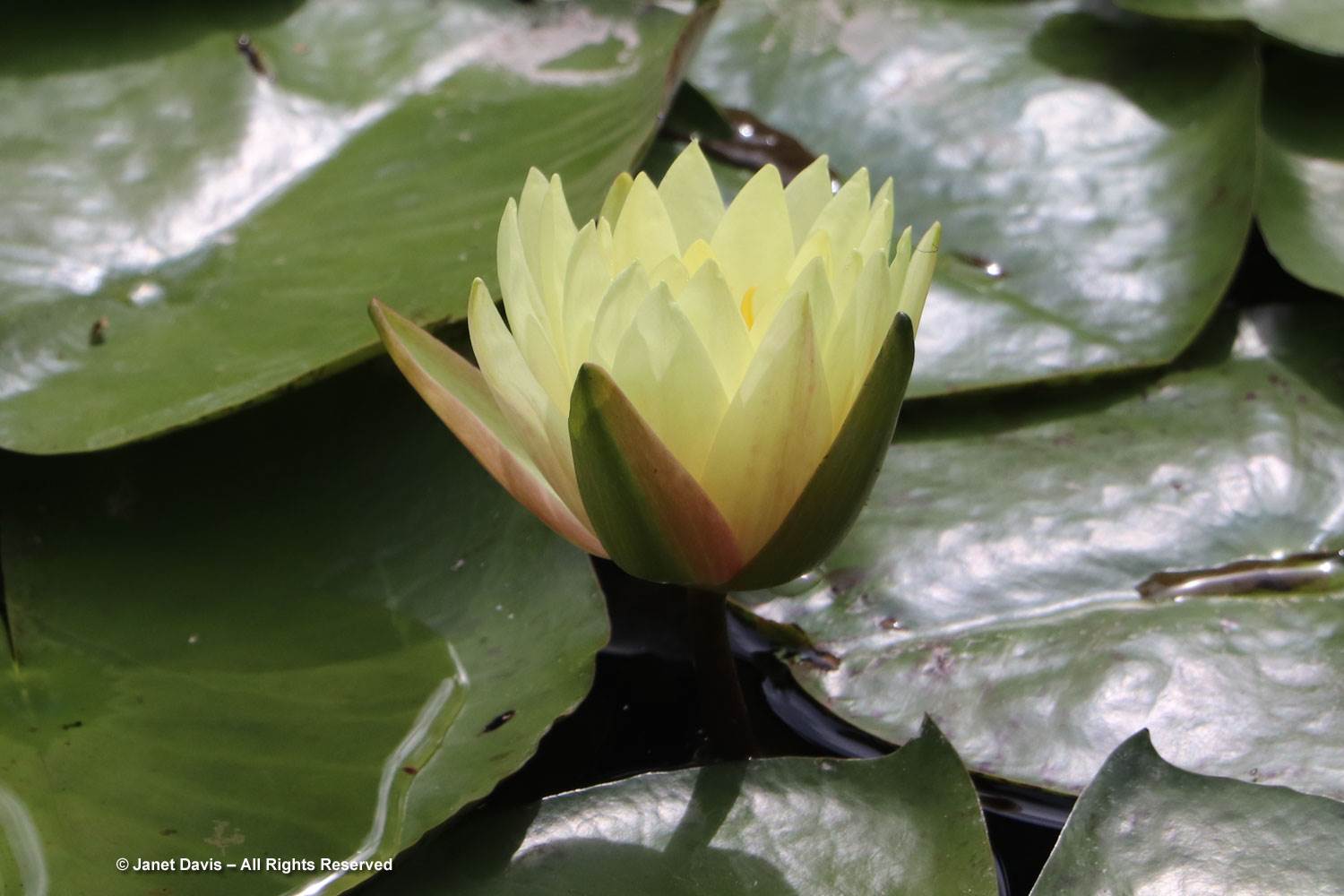
I climbed the hill toward the other gardens past the Rock Ledge – a garden that shines in late spring but looked relaxed and lovely in late summer. The Japanese maple is Acer palmatum ‘Osakazuki’.
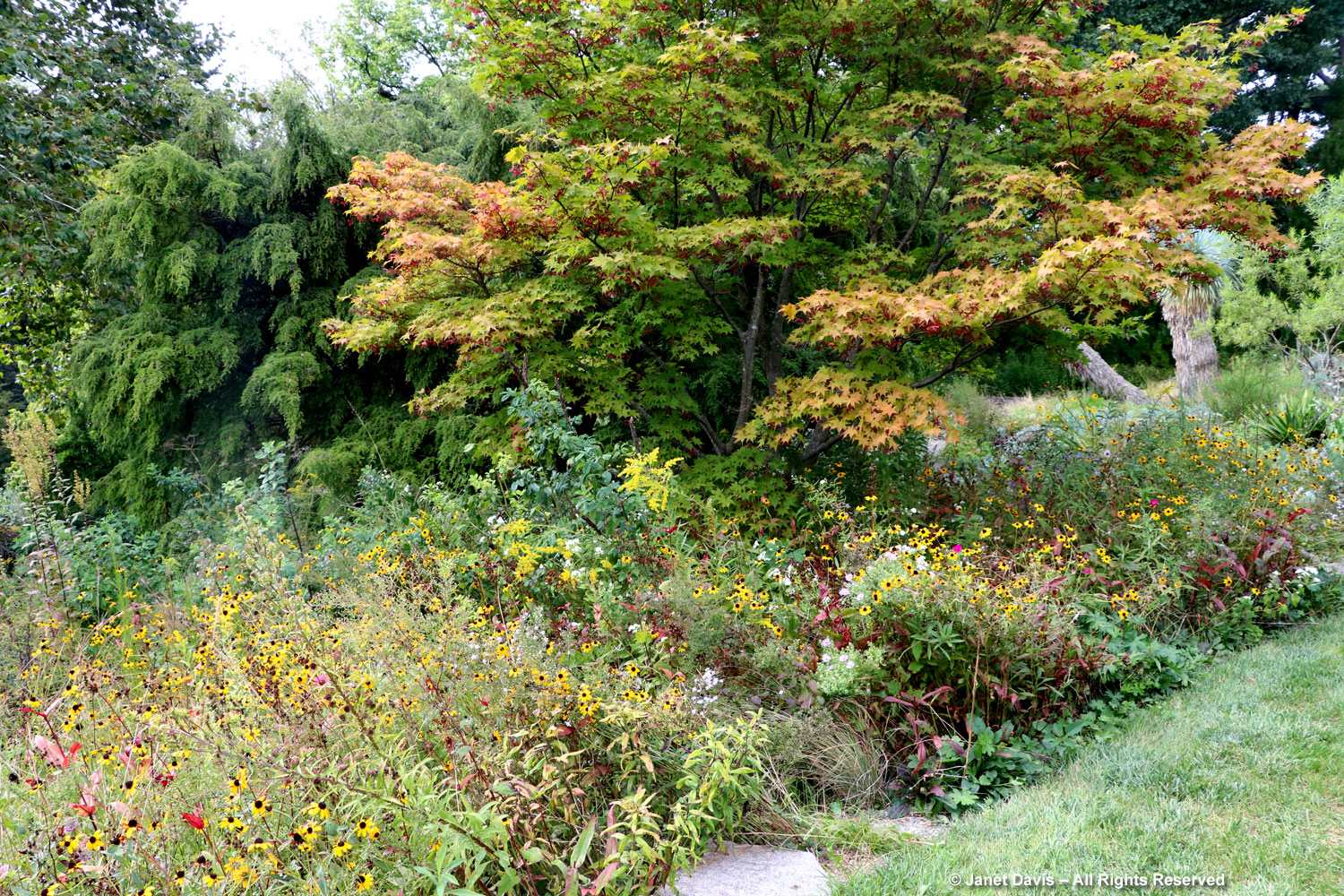
My eye caught movement in the sumptuous, blue closed bottle gentians (Gentiana andrewsii) and I stopped to watch bumble bees working feverishly to access the nectar inside.
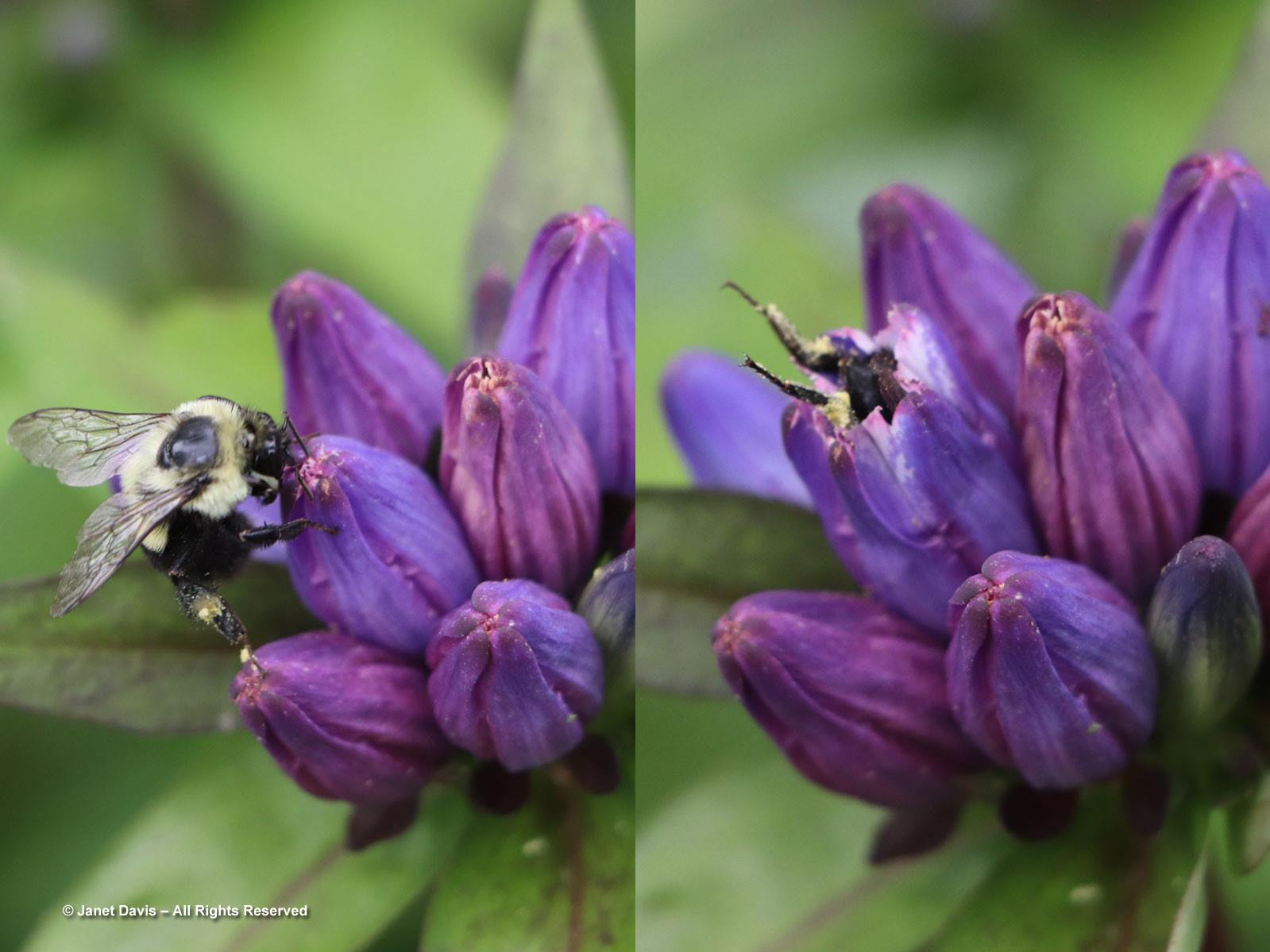
I was delighted to find Joe Henderson, the horticulturist in charge of Chanticleer’s ponds. He’s a 25-year veteran of the garden, something so vital for continuity and creativity. And I realized, while chatting with him, that I’d actually visited his personal garden on a tour long ago. Since Chanticleer had rolled out the welcome mat for the Garden Bloggers Fling, with food stations, cocktails and even a musical tent with a great band, we were fortunate to meet many of the gardeners, who were there to greet us…..
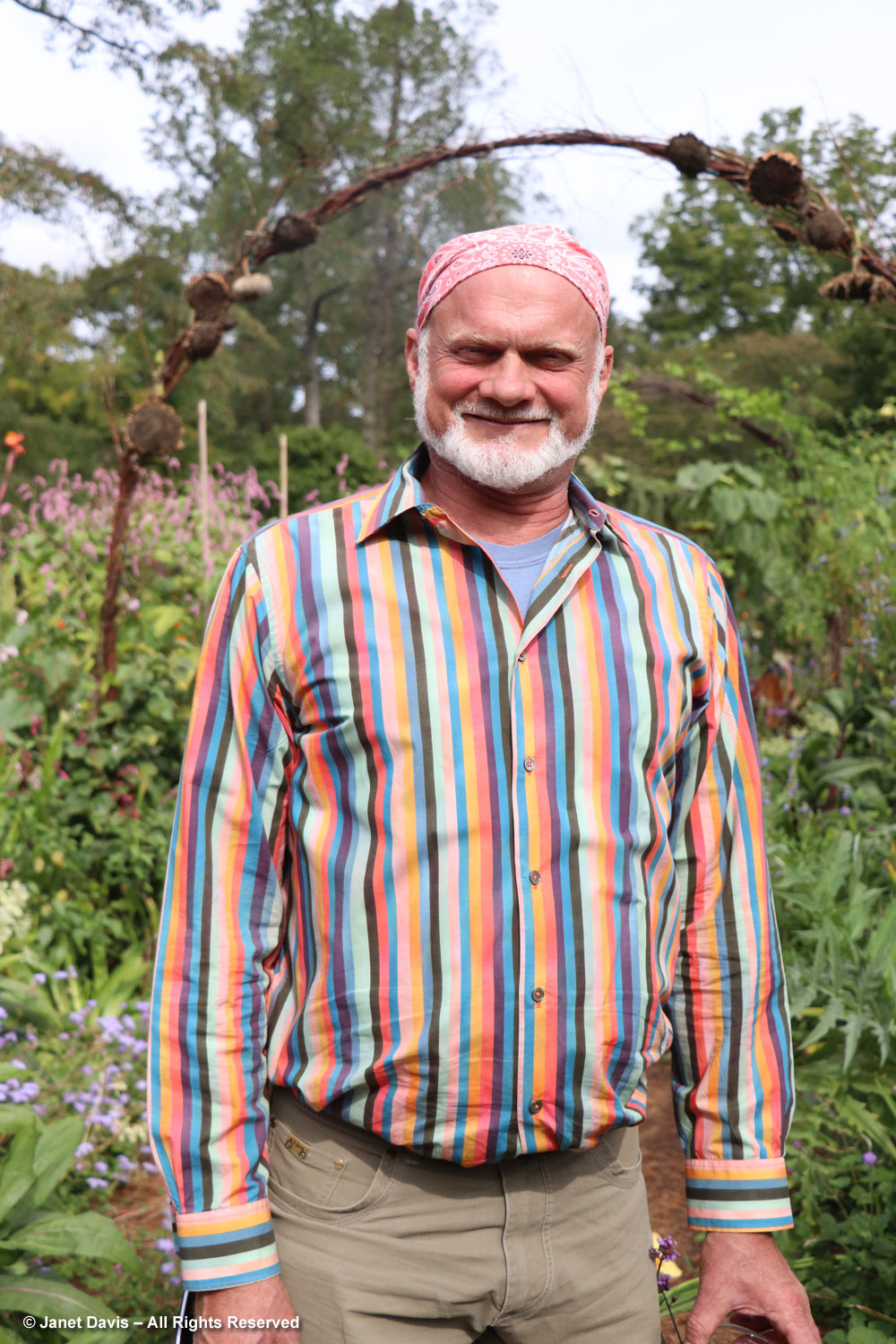
…. sometimes even acting as bartenders, like Andrew Wiley, below, who benefited this year from The Chanticleer USA Christopher Lloyd Scholarship, an exchange conceived in order to provide a gardener from the United States with a year-long, practical education in the traditional style of ornamental gardening as practised at two of the world’s most respected gardens, Great Dixter in East Sussex, England, and Chanticleer. I visited Great Dixter in early June and blogged about that fabulous garden, but missed seeing Andrew.
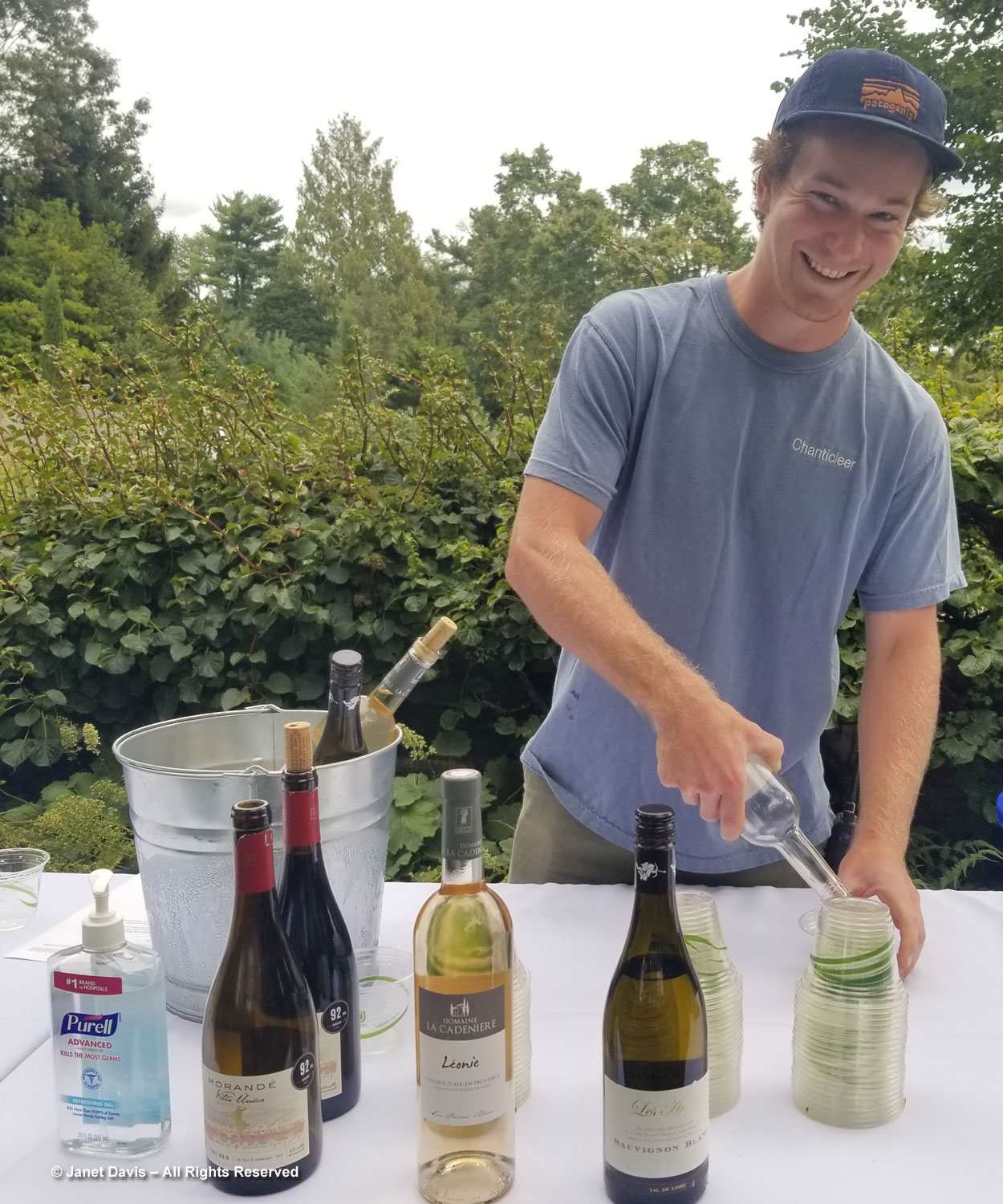
I’m going to leave the Gravel Garden, my friend Lisa Roper’s horticultural hillside domain, until Part 2 of this blog, but let’s take a peek into the Ruin Garden at the top of hill beyond some of Lisa’s treasures. This intriguing garden was built on the foundation of Minder House (1925), originally next door to Chanticleer but acquired by Adolph Rosengarten, Sr. as a 1933 wedding gift for his son Adolph Rosengarten, Jr and his wife Janet. Nine years after the death of Adolph Jr. in 1990, Minder House was razed and under Chanticleer’s former director, Chris Woods, it was rebuilt as an evocative ruin of three-stone-walled ‘rooms’ that capture its spirit. The wall below is the entrance to the “library”.
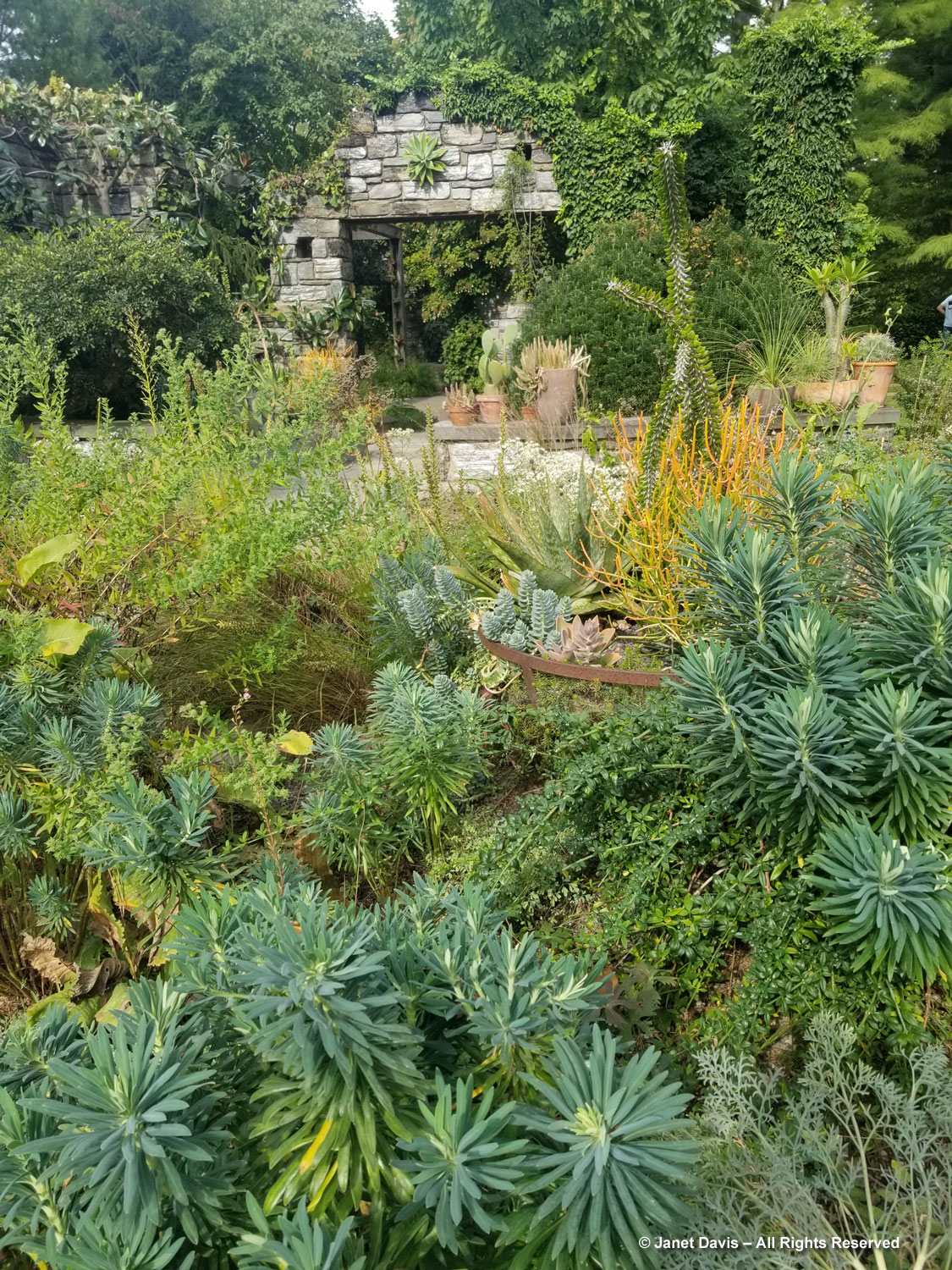
Moving around the corner of the Ruin, we see the lemon-yellow Mohr’s rosinweed (Silphium mohrii), a native that’s become very popular recently since it does not have the aggressive tendencies of its cousins.
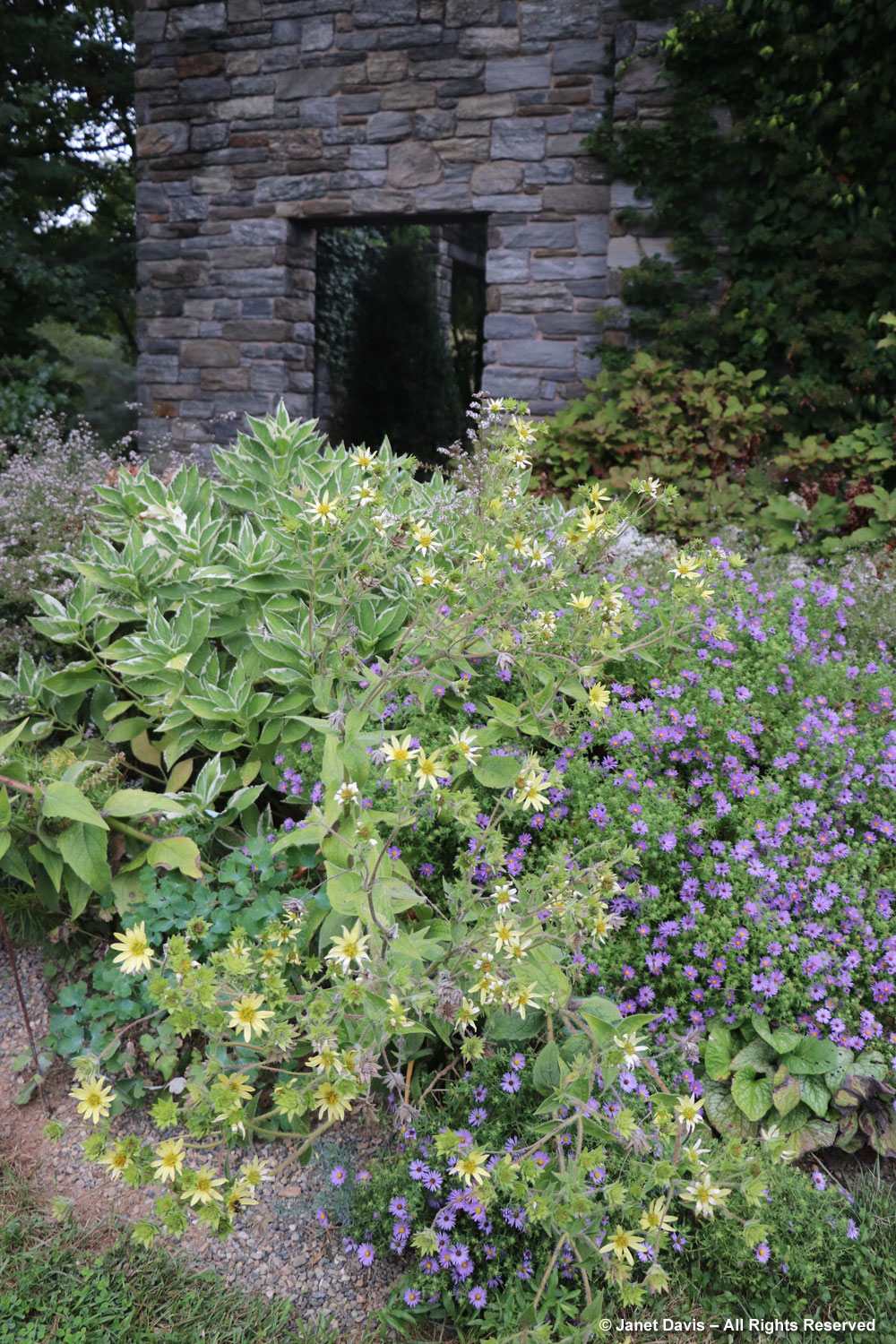
Let’s go into the Pool Room – with its interesting pool and fountain.
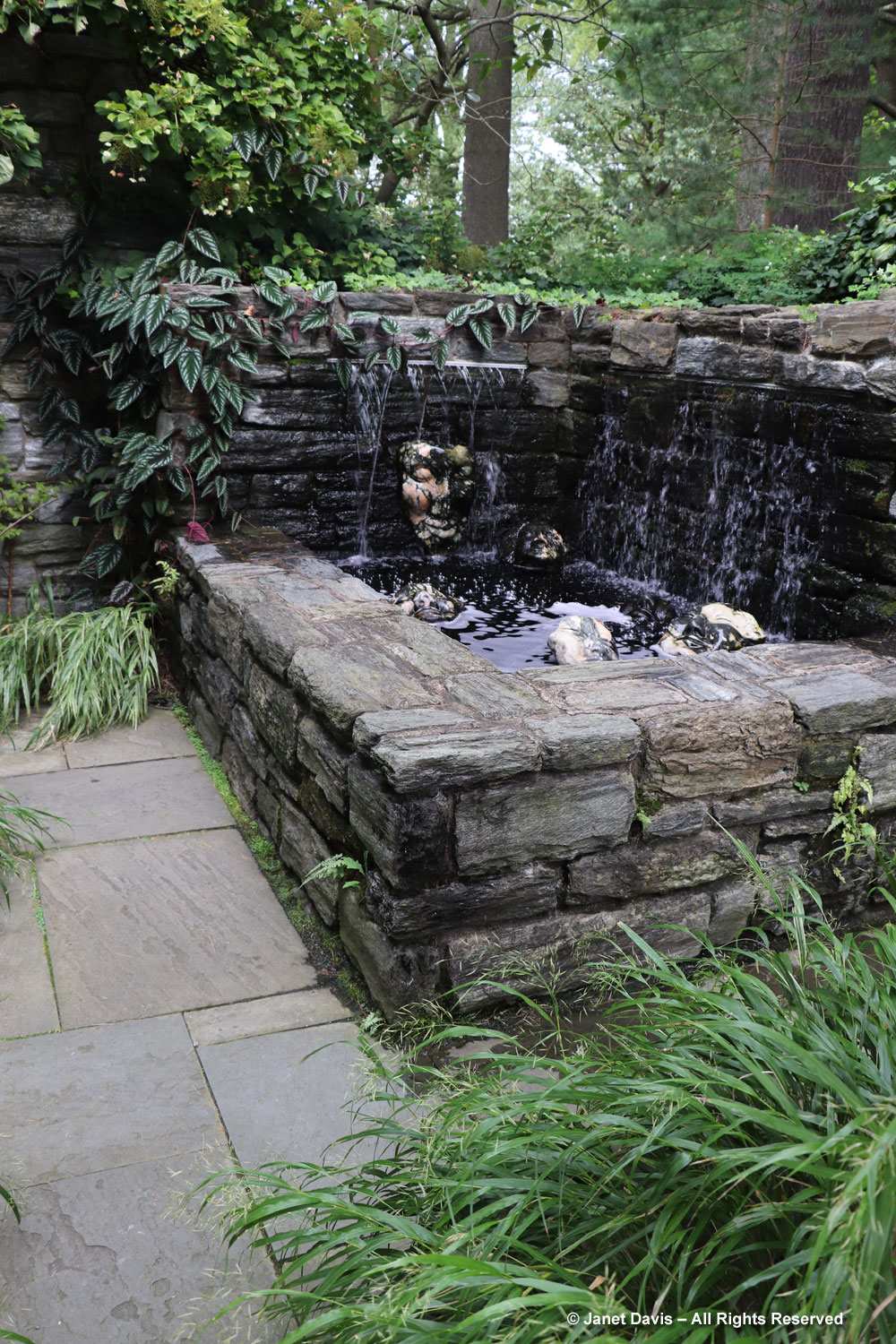
Draw a little closer and you see California sculptor Marcia Donahue’s intriguing, floating faces and the pool’s stone wall decked with beautiful Parthenocissus henryana.
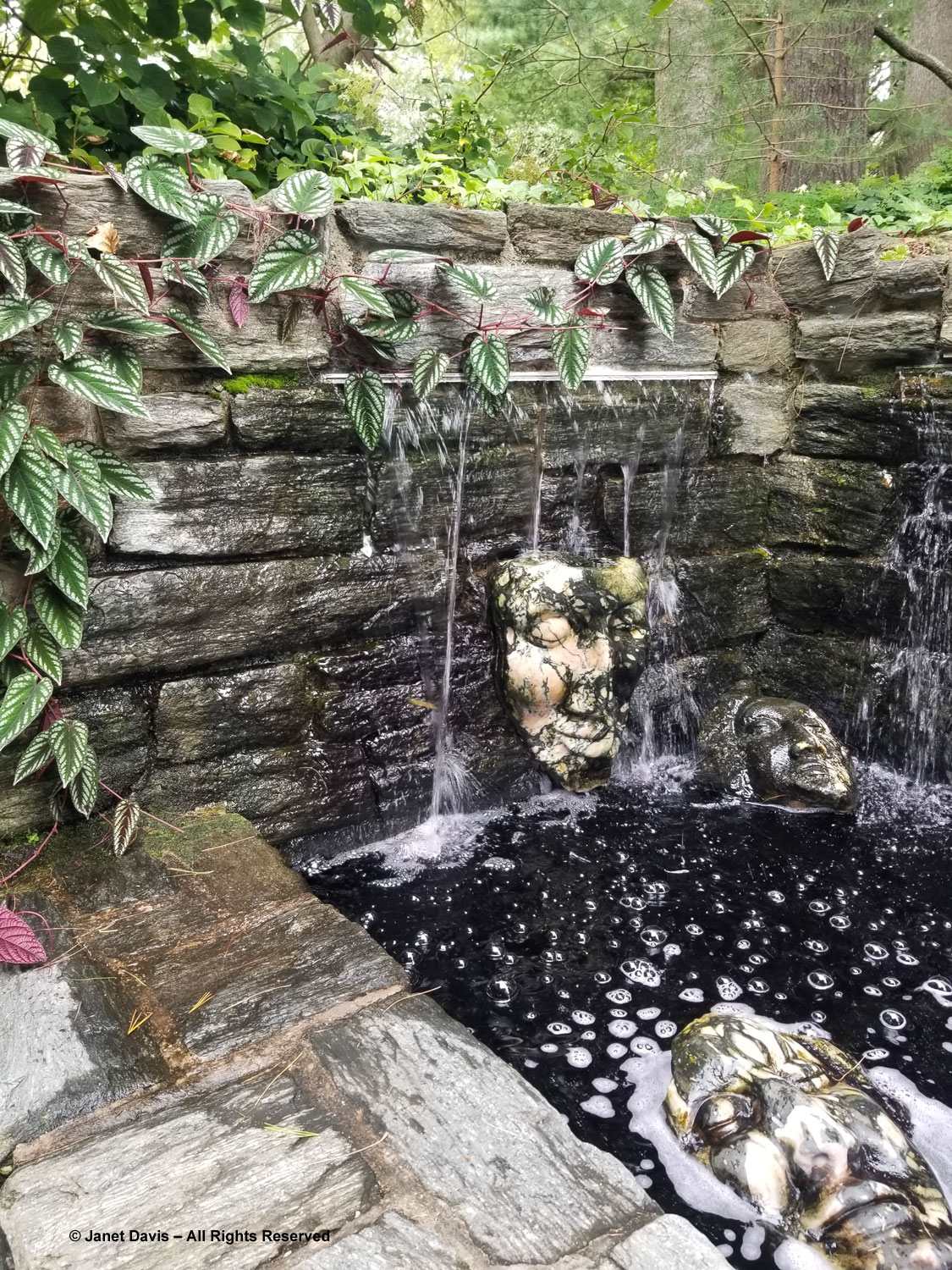
Then there’s the “pool table”….
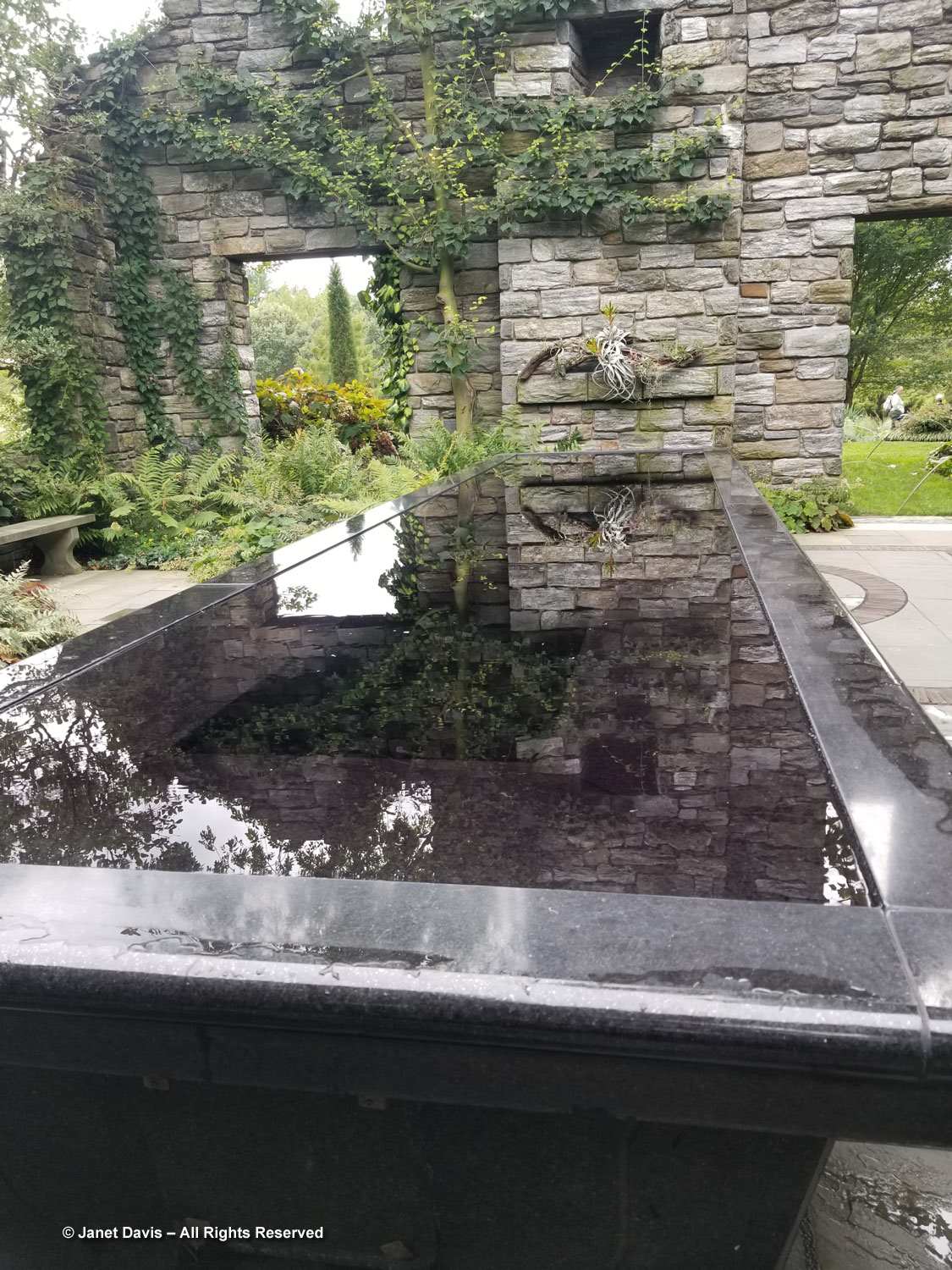
…..its surface bearing just enough water to perfectly reflect the….
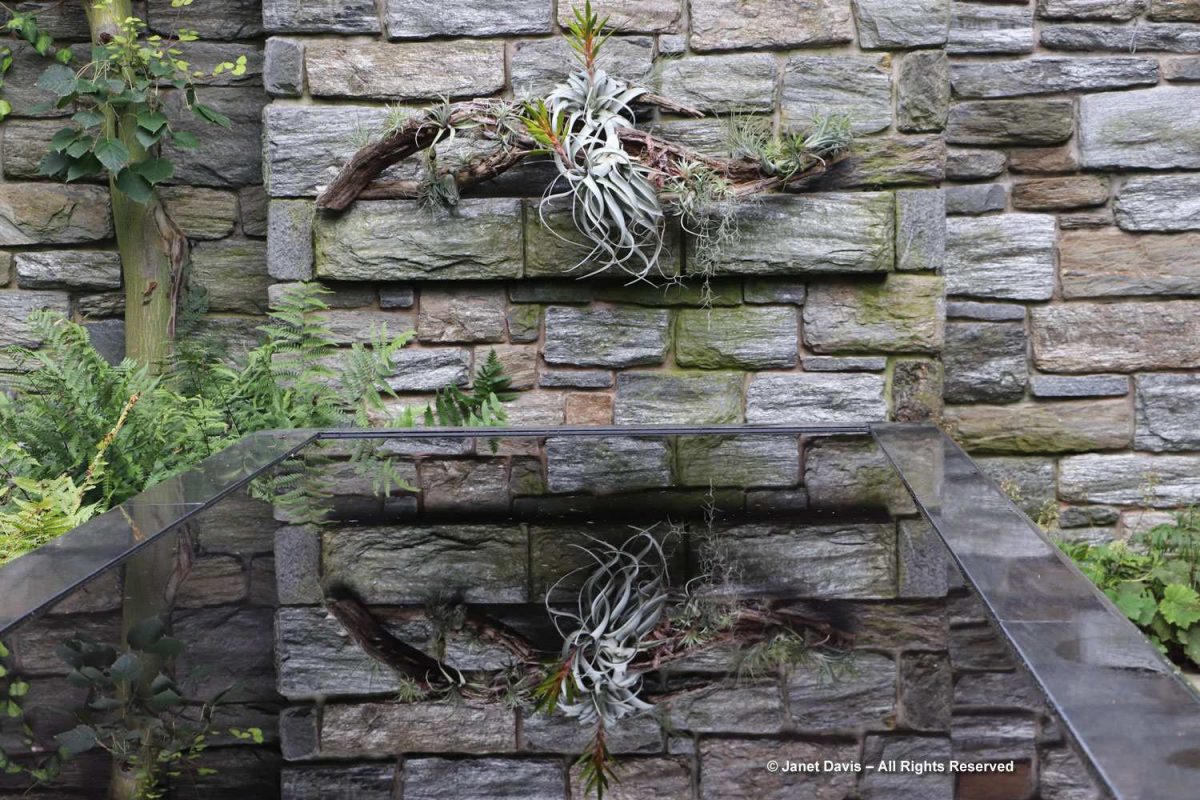
….five varieties of Tillandsia in the mantle arrangement.
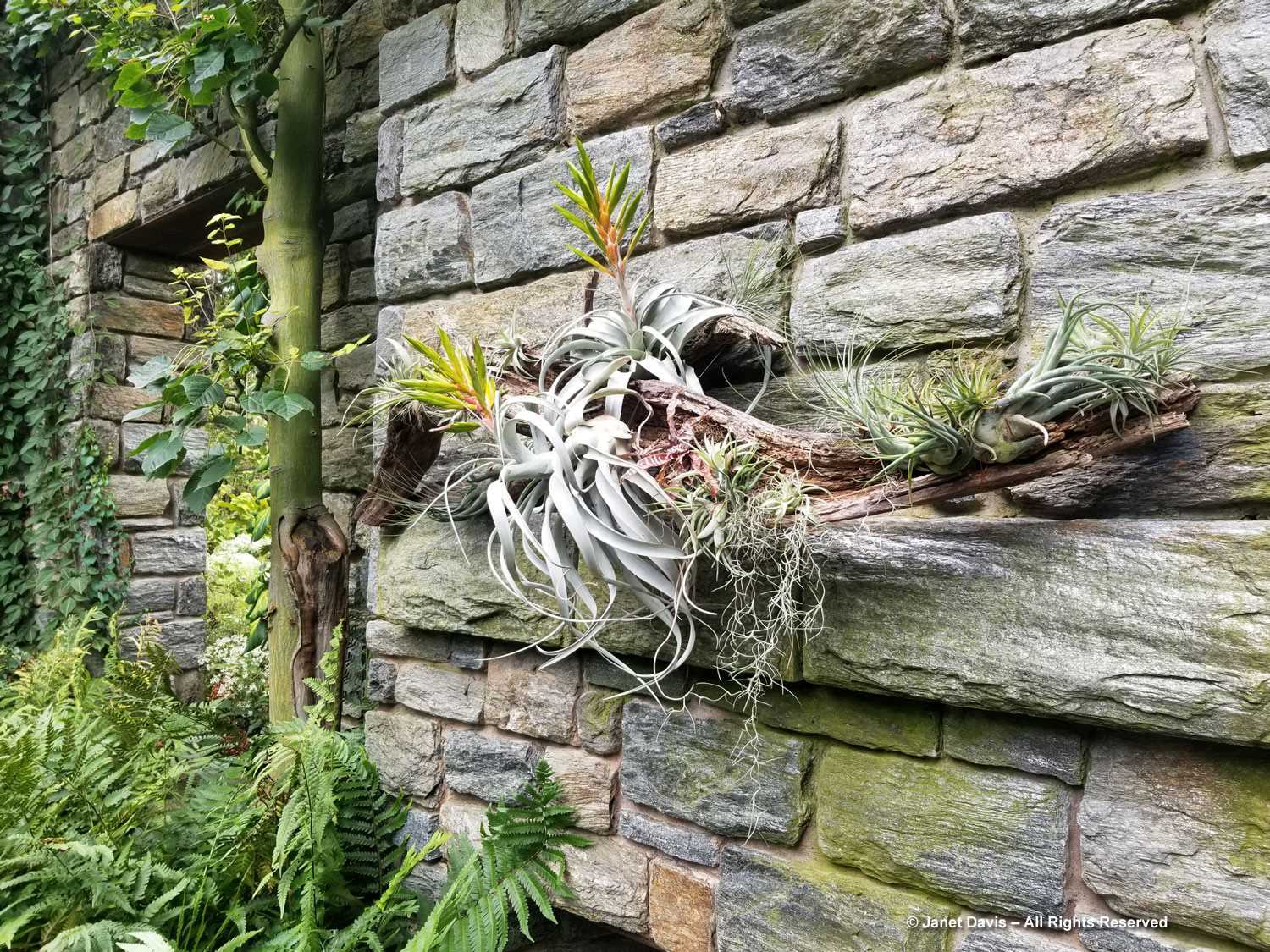
And with that, I will pause our tour until Part 2, featuring the Gravel Garden, Minder Woods and Chanticleer House with its flowery lawn. Stay tuned.
********
More Chanticleer blogs:
